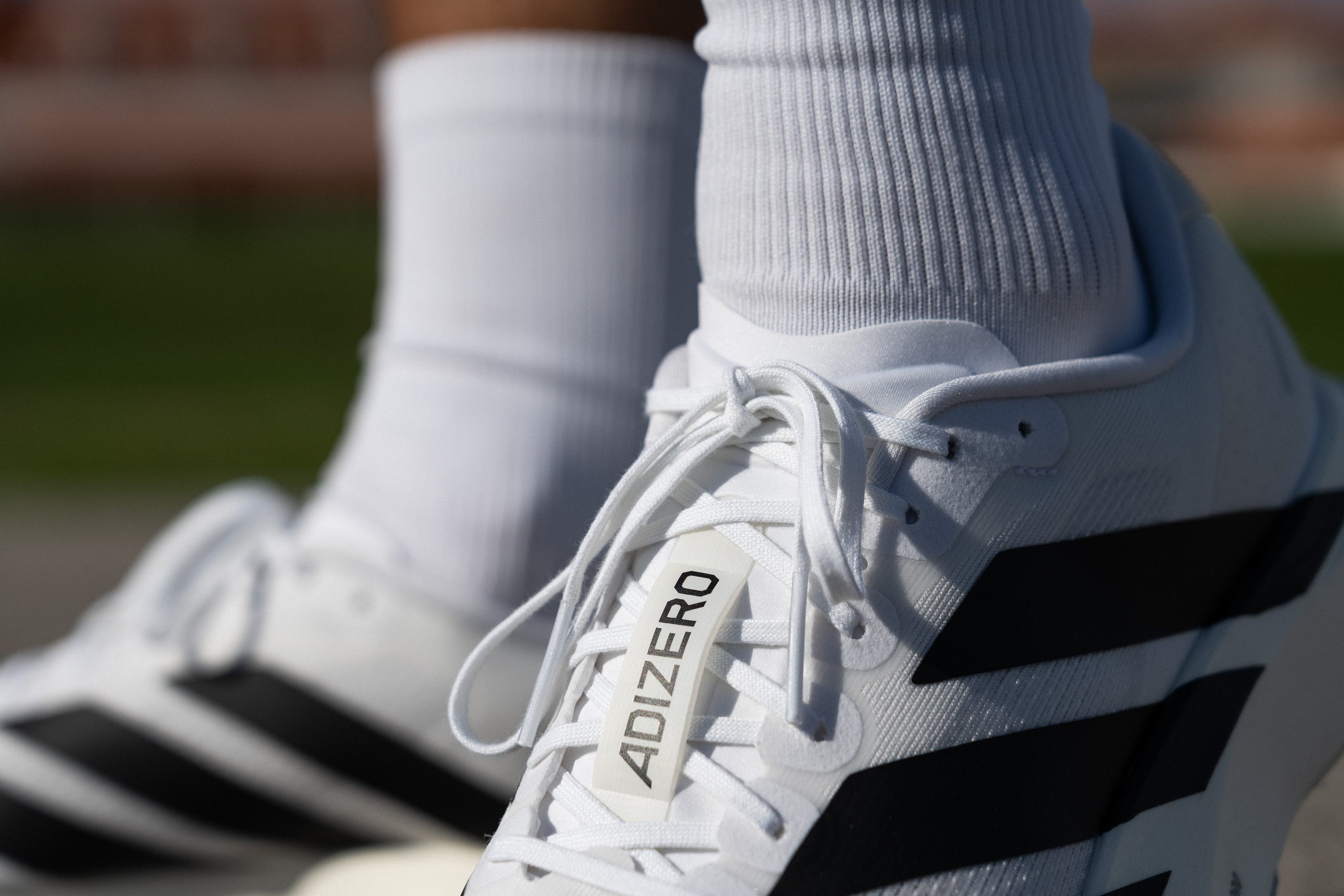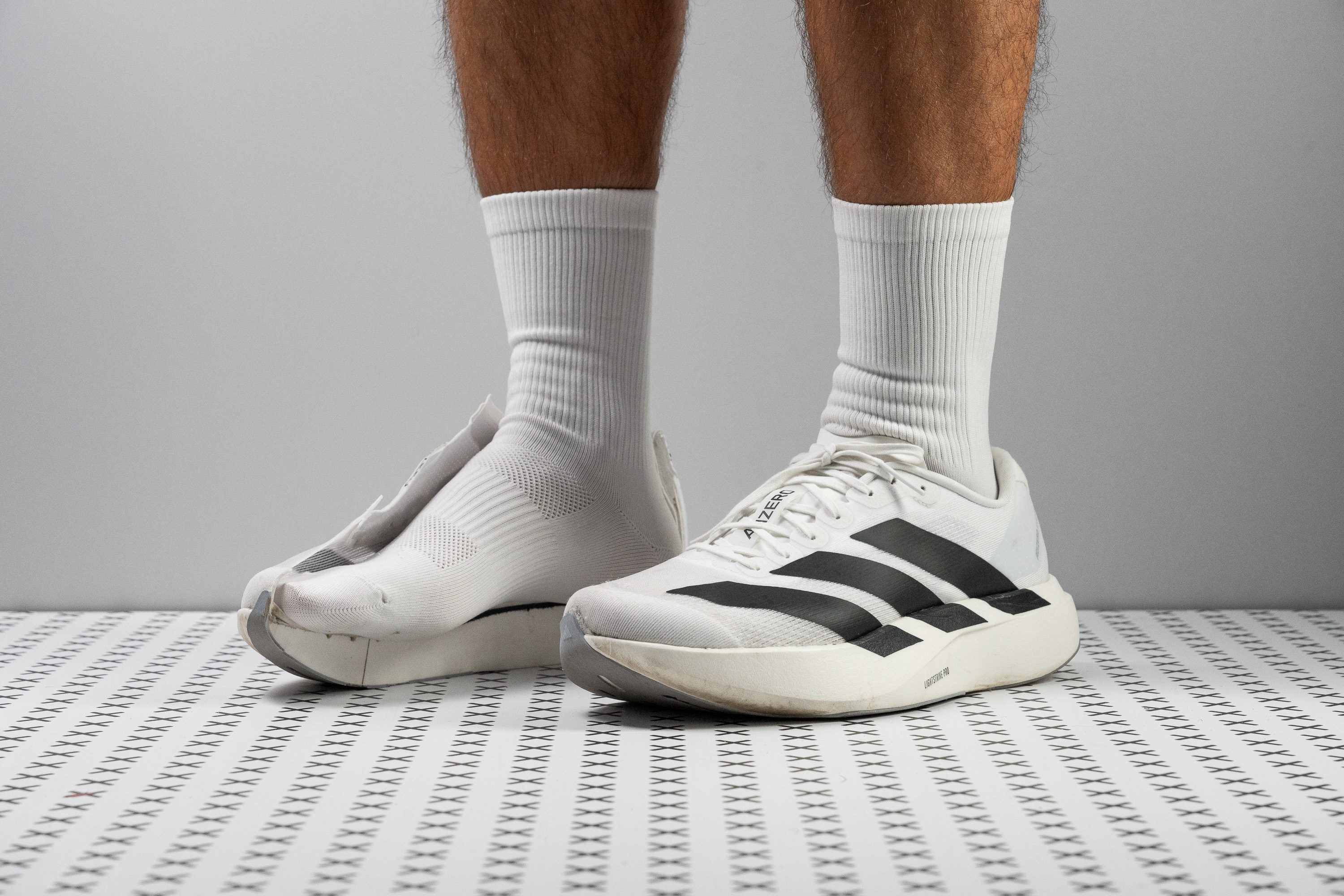Our verdict
- Top pick in best running shoes for plantar fasciitis
- Top pick in best long distance running shoes
Pros
- 100% Lightstrike Pro superfoam
- Exceptional value-to-performance ratio
- Low weight
- Ultra-breathable upper
- Unmatched versatility
- Agile and fun ride
- Handles short and long runs with ease
- Striking Evo 1-inspired aesthetics
- Striking Evo 1-inspired aesthetics
Cons
- Poor-quality laces
- Short, non-gusseted tongue
- Toebox durability
Audience verdict
- Top 2% in road running shoes
- Top 7% in Adidas running shoes
- Top 4% most popular running shoes
Comparison
The most similar running shoes compared
+ + Add a shoe | |||||
|---|---|---|---|---|---|
| Audience score | 93 Superb! | 89 Great! | 89 Great! | 87 Great! | |
| Price | £130 | £120 | £150 | £140 | |
| Pace | Daily runningTempo | Daily running | Daily running | Daily running | |
| Shock absorption | High | High | Moderate | High | |
| Energy return | High | Low | High | High | |
| Traction | Moderate | Moderate | Moderate | High | |
| Arch support | Neutral | Neutral | Neutral | Neutral | |
| Weight lab Weight brand | 7.9 oz / 223g 7.9 oz / 224g | 9.7 oz / 274g 9.5 oz / 270g | 9.9 oz / 281g 10 oz / 284g | 8.2 oz / 232g 8.3 oz / 235g | |
| Lightweight | ✓ | ✗ | ✗ | ✓ | |
| Drop lab Drop brand | 8.0 mm 6.5 mm | 10.5 mm 5.0 mm | 8.9 mm 8.0 mm | 9.6 mm 5.0 mm | |
| Strike pattern | HeelMid/forefoot | Heel | HeelMid/forefoot | HeelMid/forefoot | |
| Size | True to size | True to size | True to size | True to size | |
| Midsole softness | Balanced | Soft | Balanced | Balanced | |
| Difference in midsole softness in cold | Small | Normal | Small | Big | |
| Toebox durability | Bad | Bad | Decent | Decent | |
| Heel padding durability | Good | Decent | Bad | Bad | |
| Outsole durability | Good | Good | Bad | Good | |
| Breathability | Breathable | Breathable | Moderate | Breathable | |
| Width / fit | Medium | Medium | Medium | Medium | |
| Toebox width | Medium | Medium | Medium | Narrow | |
| Stiffness | Flexible | Moderate | Moderate | Moderate | |
| Torsional rigidity | Stiff | Stiff | Stiff | Stiff | |
| Heel counter stiffness | Moderate | Stiff | Stiff | Stiff | |
| Rocker | ✓ | ✗ | ✓ | ✓ | |
| Heel lab Heel brand | 36.1 mm 38.5 mm | 40.7 mm 40.0 mm | 36.1 mm 37.0 mm | 36.0 mm 37.0 mm | |
| Forefoot lab Forefoot brand | 28.1 mm 32.0 mm | 30.2 mm 35.0 mm | 27.2 mm 29.0 mm | 26.4 mm 32.0 mm | |
| Widths available | NormalWide | NormalWide | Normal | NormalWide | |
| Orthotic friendly | ✓ | ✓ | ✓ | ✓ | |
| Season | SummerAll seasons | SummerAll seasons | All seasons | SummerAll seasons | |
| Removable insole | ✓ | ✓ | ✓ | ✓ | |
| Ranking | #3 Top 1% | #103 Top 28% | #91 Top 25% | #158 Top 43% | |
| Popularity | #15 Top 4% | #242 Bottom 35% | #232 Bottom 38% | #18 Top 5% |
Who should buy
Despite its limited early release, we managed to buy a pair of the Adizero EVO SL, and after dissecting it and testing every detail, we recommend it for:
- Beginners wanting a do-it-all shoe for training and racing that offers reliable performance at an unbeatable price.
- Anyone seeking a speedy, durable and fun training partner.
- Runners who dislike carbon plates but crave world-class performance and grip.
- Those searching for a versatile shoe with premium foam without breaking the bank.
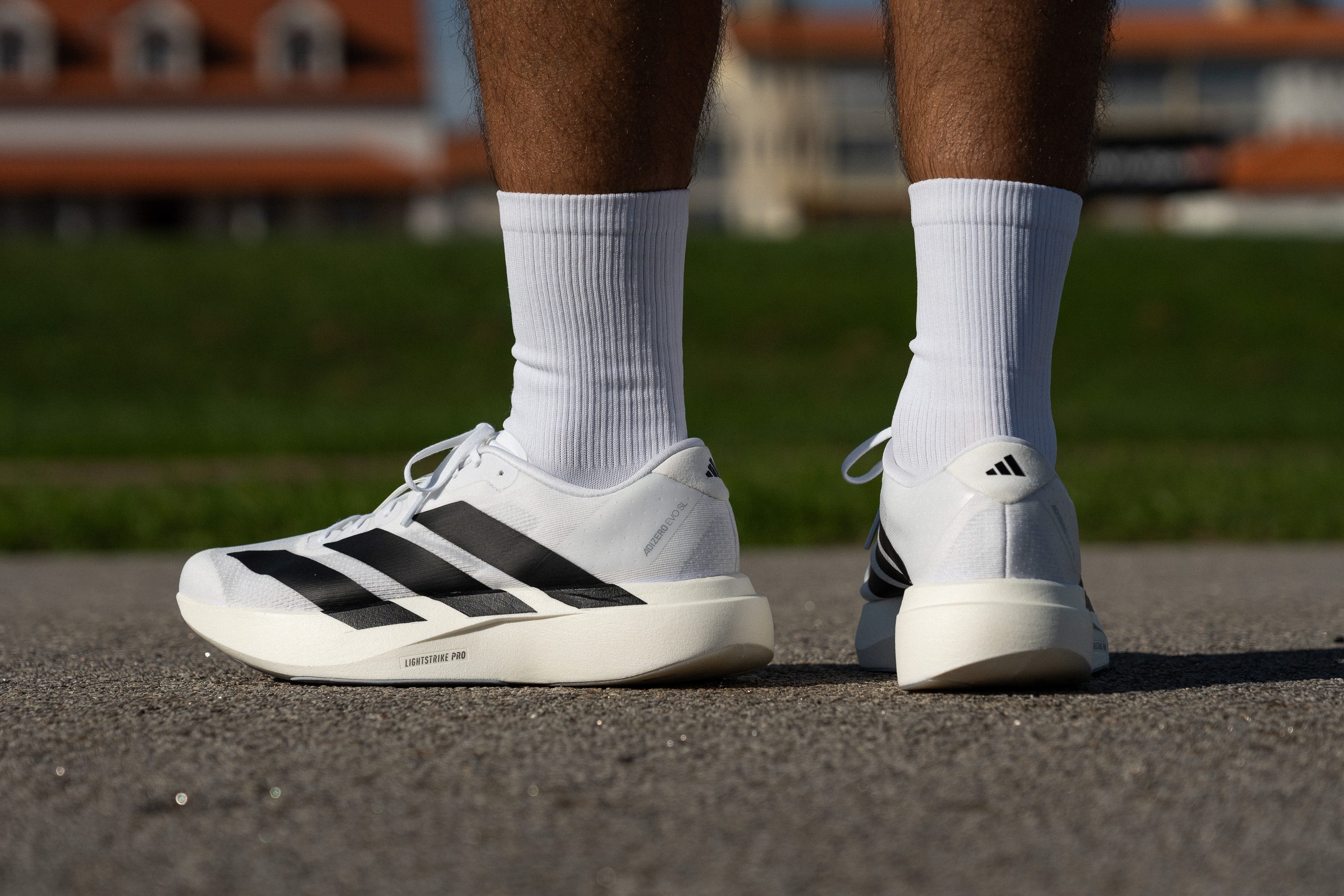
Who should NOT buy
The EVO SL impressed us in many ways, but we think it’s not the best choice for runners with stability concerns. Its narrow midsole and lack of support make it unsuitable for those needing even mild support. In our view, a better alternative would be the ASICS Superblast 2, which offers a more stable platform and an improved upper—addressing one of the EVO SL’s weakest points.
Additionally, we know this shoe won’t satisfy runners seeking the sensation of a plate. The EVO SL is designed for a more natural ride. For those desiring a plated trainer, we recommend the PUMA Deviate Nitro 3 or the Saucony Endorphin Speed 4.
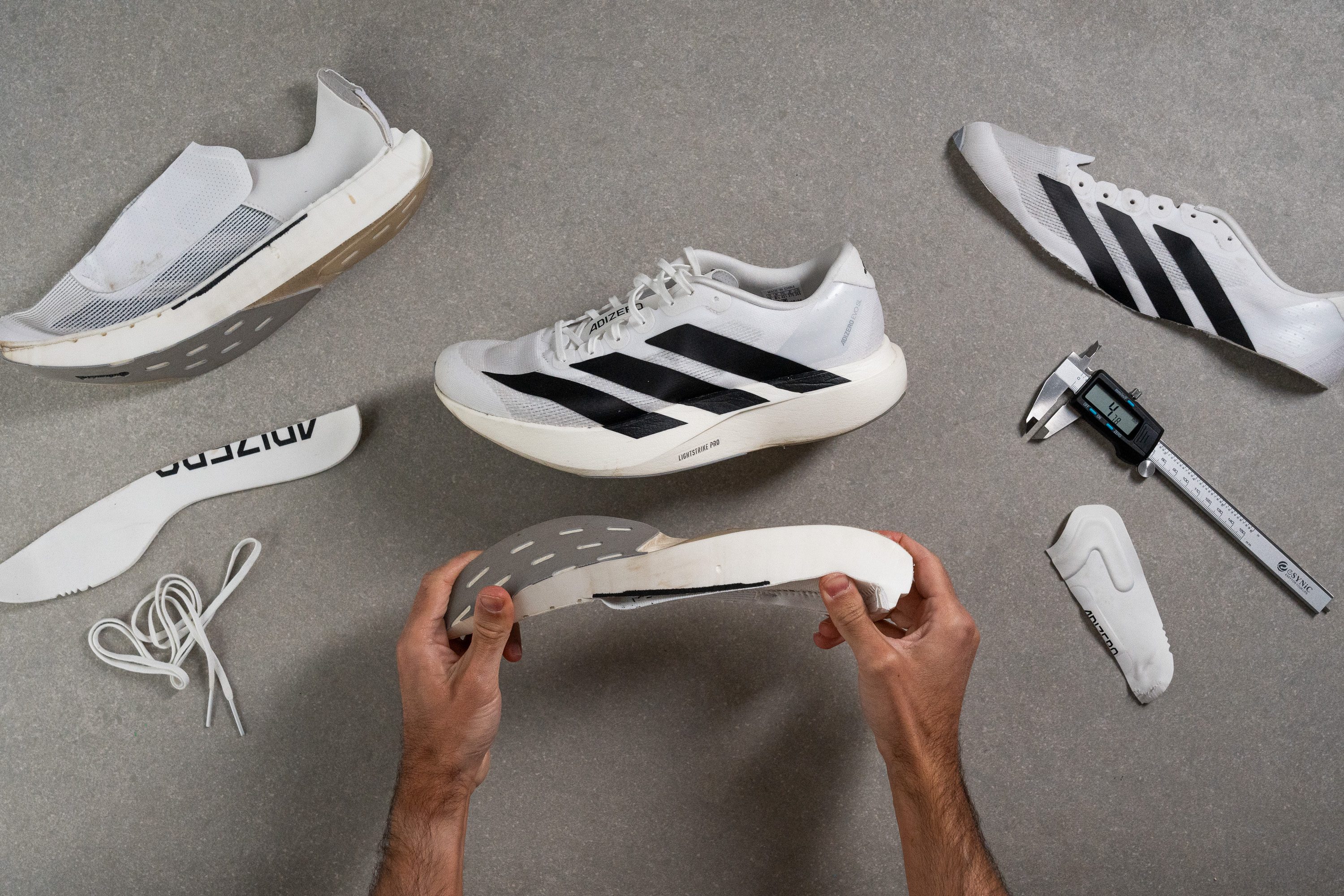
Finally, the limited early release by Adidas might make it impossible to spend your money on this shoe. If it’s unavailable but you’re seeking a similar experience, we believe the New Balance FuelCell Rebel v4 or the Nike Pegasus Plus offer the closest running feel to the EVO SL, both being widely available worldwide.
Cushioning
Shock absorption
The EVO SL stands out for its high-impact cushioning, delivering an impressive 147 SA in the heel.
We found that this shock-absorbing performance rivals much heavier, max-cushioned models designed for serious mileage. In fact, it's one of the few shoes outside the supershoe category to blend a feather-light build with marathon-ready protection.

| Adizero EVO SL | 147 SA |
| Average | 129 SA |
Energy return
But wait, because it gets even better. With 74.3% energy return, this shoe plays in the top league for bounce, yet costs significantly less than most others hitting similar numbers.
We found this incredibly impressive, making the EVO SL a race-ready option for runners who want a more forgiving, plate-free ride.
| Adizero EVO SL | 74.3% |
| Average | 58.5% |
Heel stack
Adidas officially lists the EVO SL at 38.5 mm in the heel and 32 mm in the forefoot for a US 9 sample size, but we discovered slight differences in our pair here in the lab. Specifically, we measured 36.1 mm in the heel—a negligible variation that’s imperceptible during runs anyway.
This stack height strikes a sweet spot for a versatile shoe like this. We think anything over 40 mm would have introduced excessive weight and instability, while a thinner midsole might have ruled out long runs or even races for those who prefer non-plated shoes. And yes, the EVO SL is undoubtedly capable of handling a full marathon with ease.
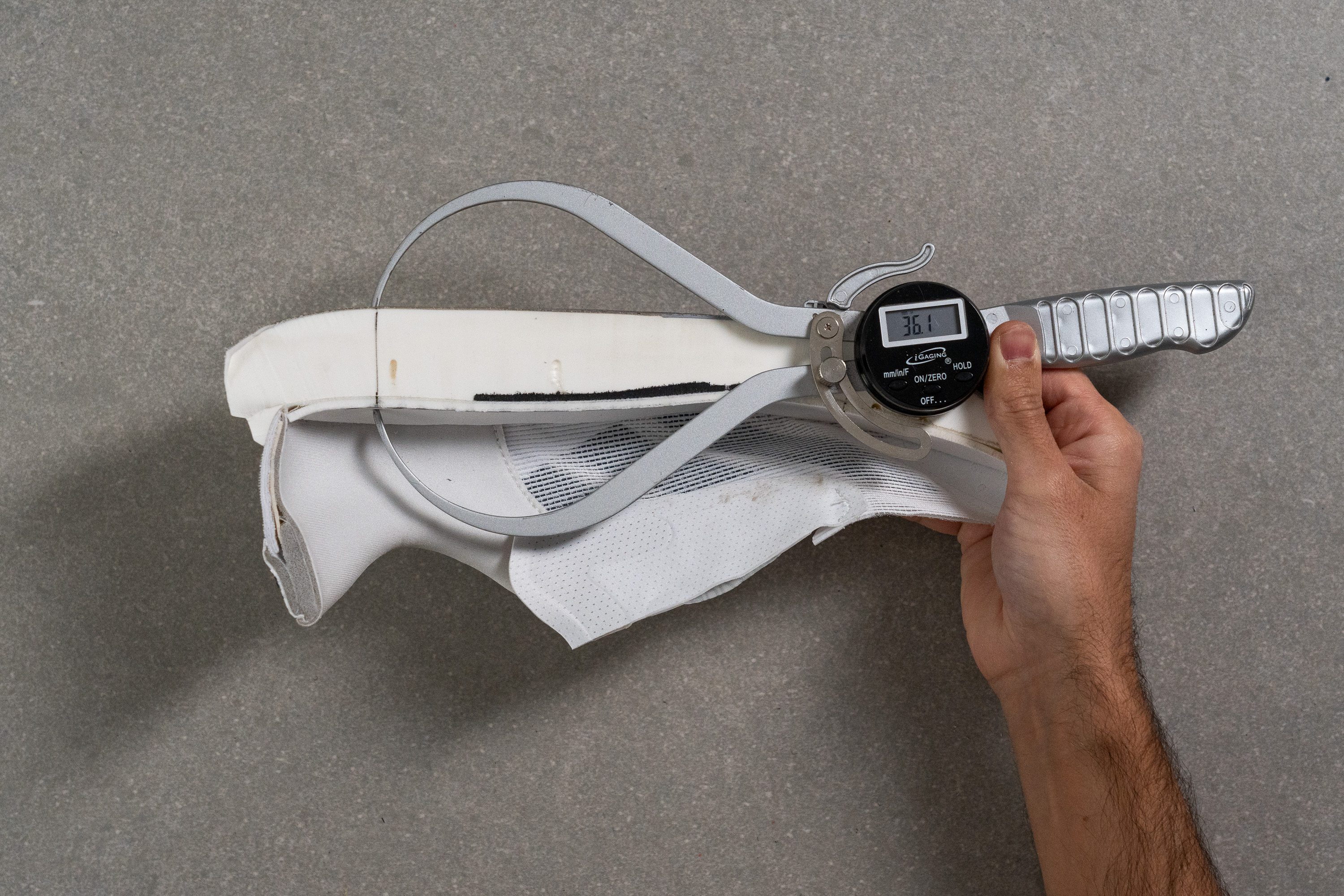
| Adizero EVO SL | 36.1 mm |
| Average | 34.8 mm |
Forefoot stack
The forefoot also measured slightly lower than listed, at 28.1 mm. Nonetheless, this stack height boosts its versatility—perfect for transitioning effortlessly between easy runs and speed sessions, offering solid muscle and joint protection while still providing a touch of ground feel for those who appreciate it.
To put 28.1 mm into perspective, it's almost the same forefoot stack height of the legendary Vaporfly 4%—the shoe that kickstarted the entire supershoe revolution!
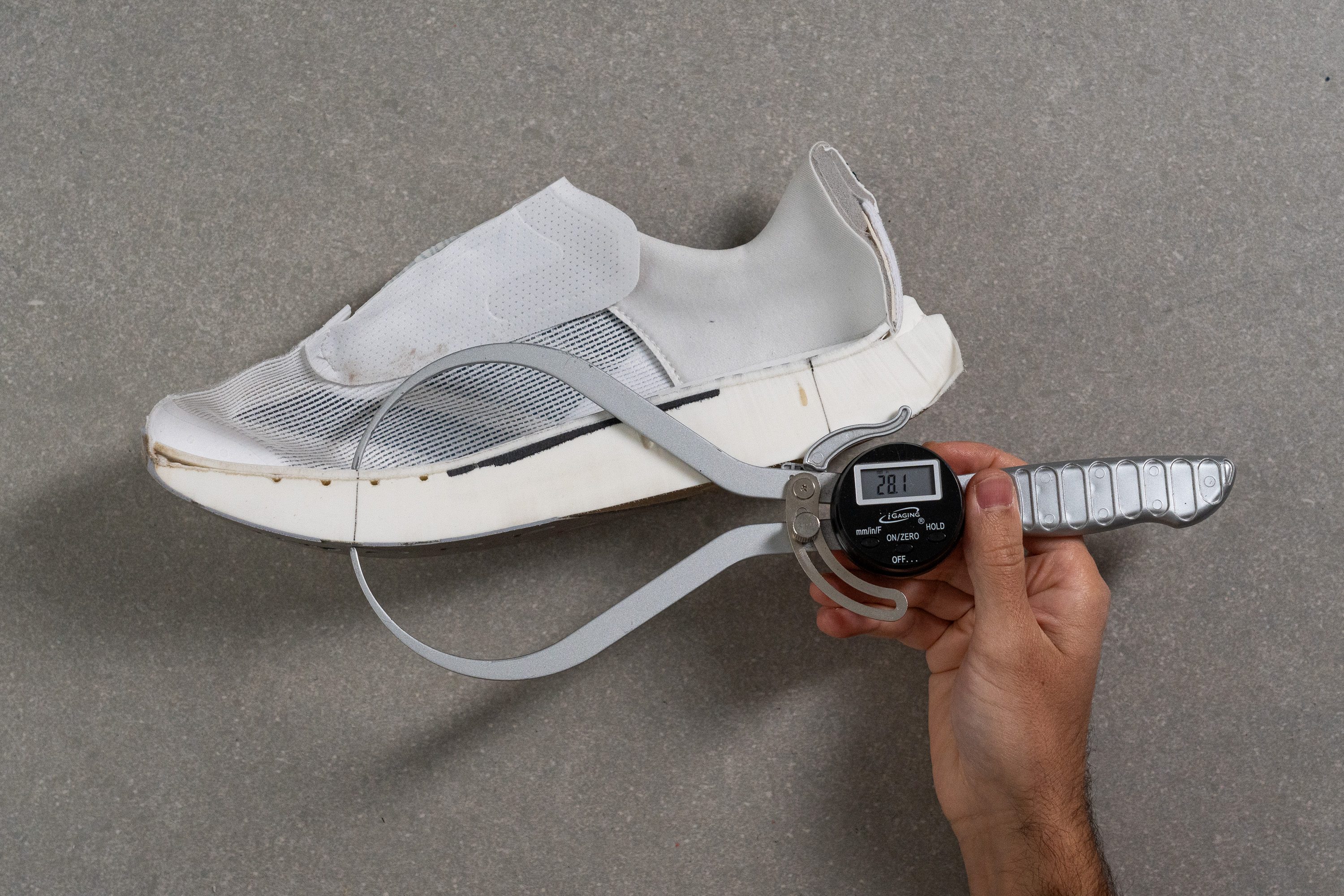
| Adizero EVO SL | 28.1 mm |
| Average | 26.2 mm |
Drop
Based on the previous two measurements, we found a small, non-concerning variation from the listed 6.5 mm to the actual 8.0 mm recorded in our lab. We believe this shoe performs best for midfoot strikers, but it accommodates all running styles—perhaps only excluding extreme heel strikers.
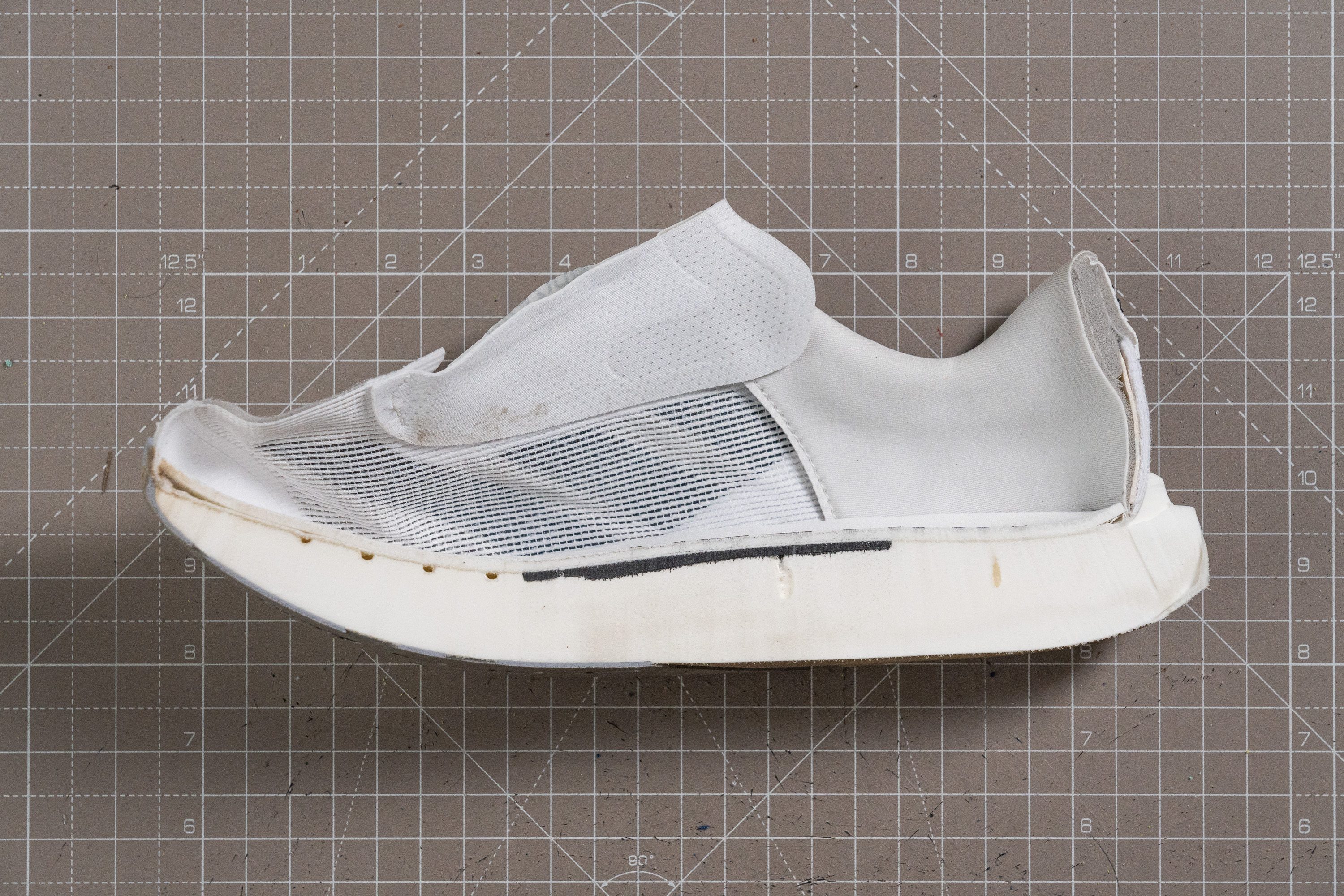
| Adizero EVO SL | 8.0 mm |
| Average | 8.6 mm |
Midsole softness
The midsole is where the magic truly happens in this shoe. Lightstrike Pro ranks as one of our favourite superfoams, showcasing an extraordinary blend of durability and performance that, in our experience, still remains unmatched. And trust us—we’ve tested plenty of foams.
The Adizero EVO SL basically defies its £150 price point with a full 100% Lightstrike Pro midsole, delivering the same propulsive, spring-like ride that anyone familiar with this foam would expect. The energy return is tremendous for a daily trainer yet it also feels somewhat stable—at least way more than Nike's ZoomX. That's a nice bonus in a jack-of-all-trades running shoe.
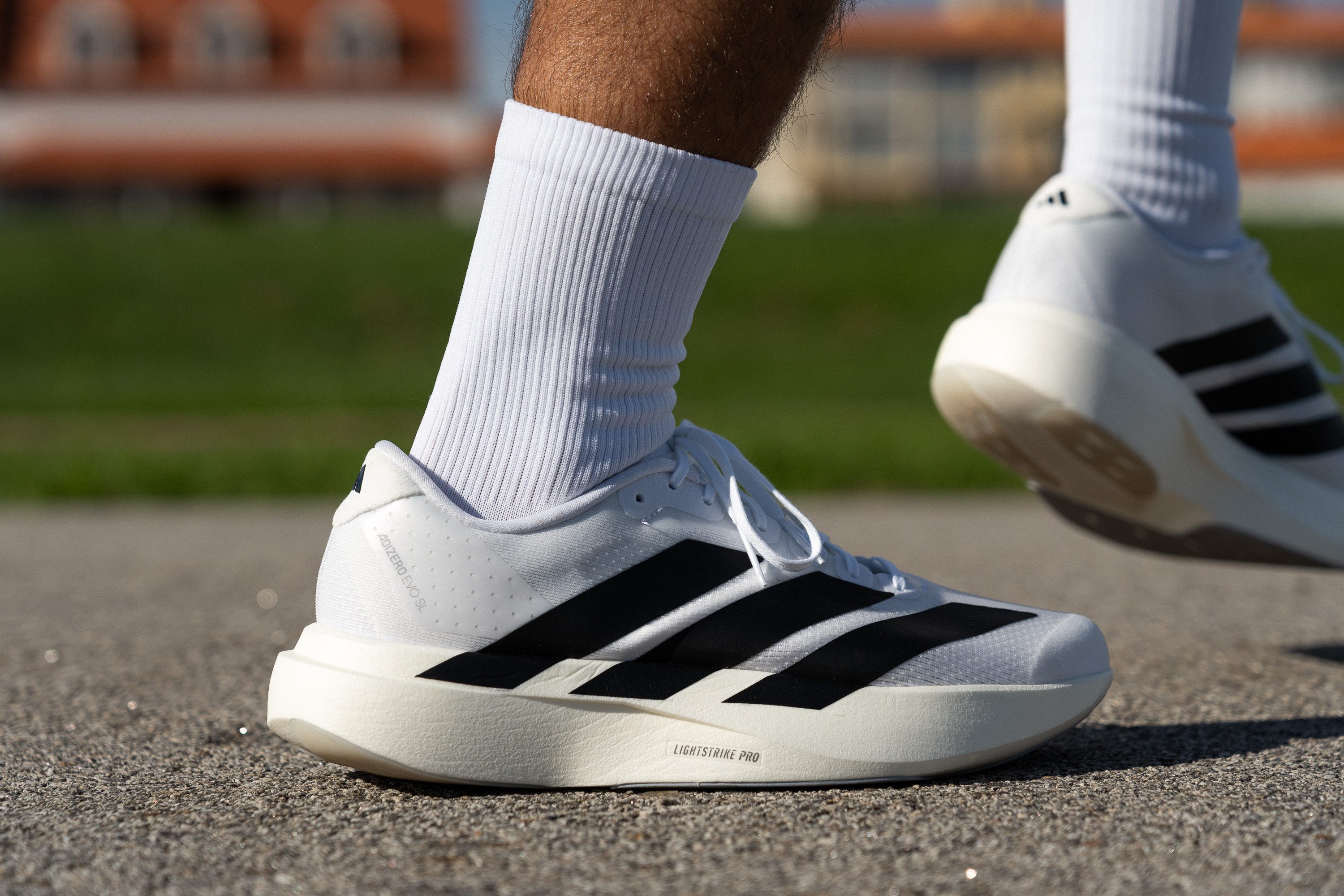
Our Shore A durometer reading of 21.3 HA confirmed what we felt—a balanced, springy running experience that works beautifully across various paces, although we think it shines the most between marathon pace and high zone 2 aerobic runs.
We want to highlight that the foam is completely pure, with no carrier foams or thick protective coatings that add weight. While this might suggest potential durability issues, the Adios Pro 3 has proven otherwise after more than two years on the market with the same unprotected foam.
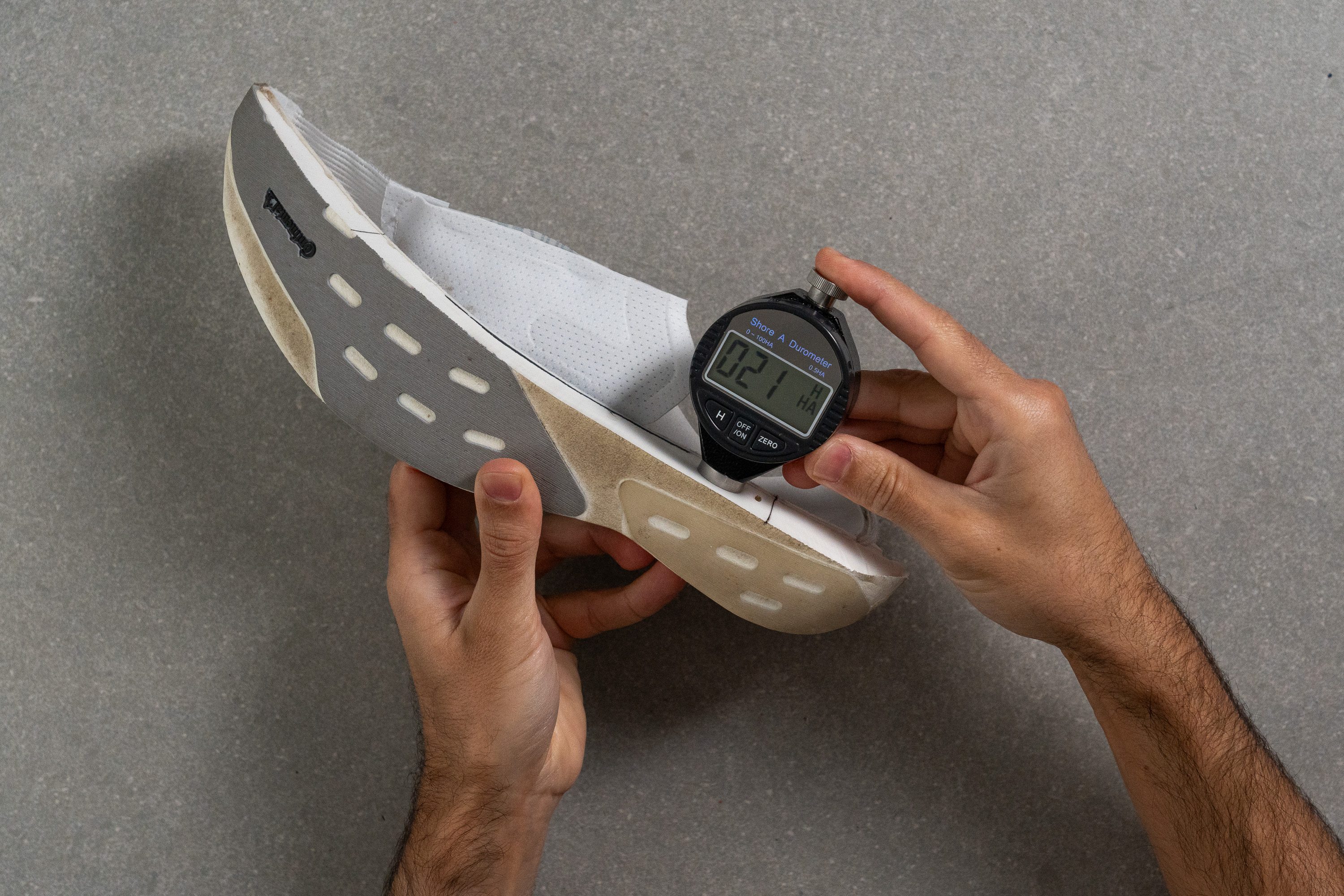
| Adizero EVO SL | 21.3 HA |
| Average | 20.4 HA |
Rocker
We found a smooth, gradual rocker in the forefoot that feels natural and highly effective. The heel features only a subtle curve, which aligns perfectly with the shoe’s design—clearly intended for runners who strike at the midfoot or forefoot.
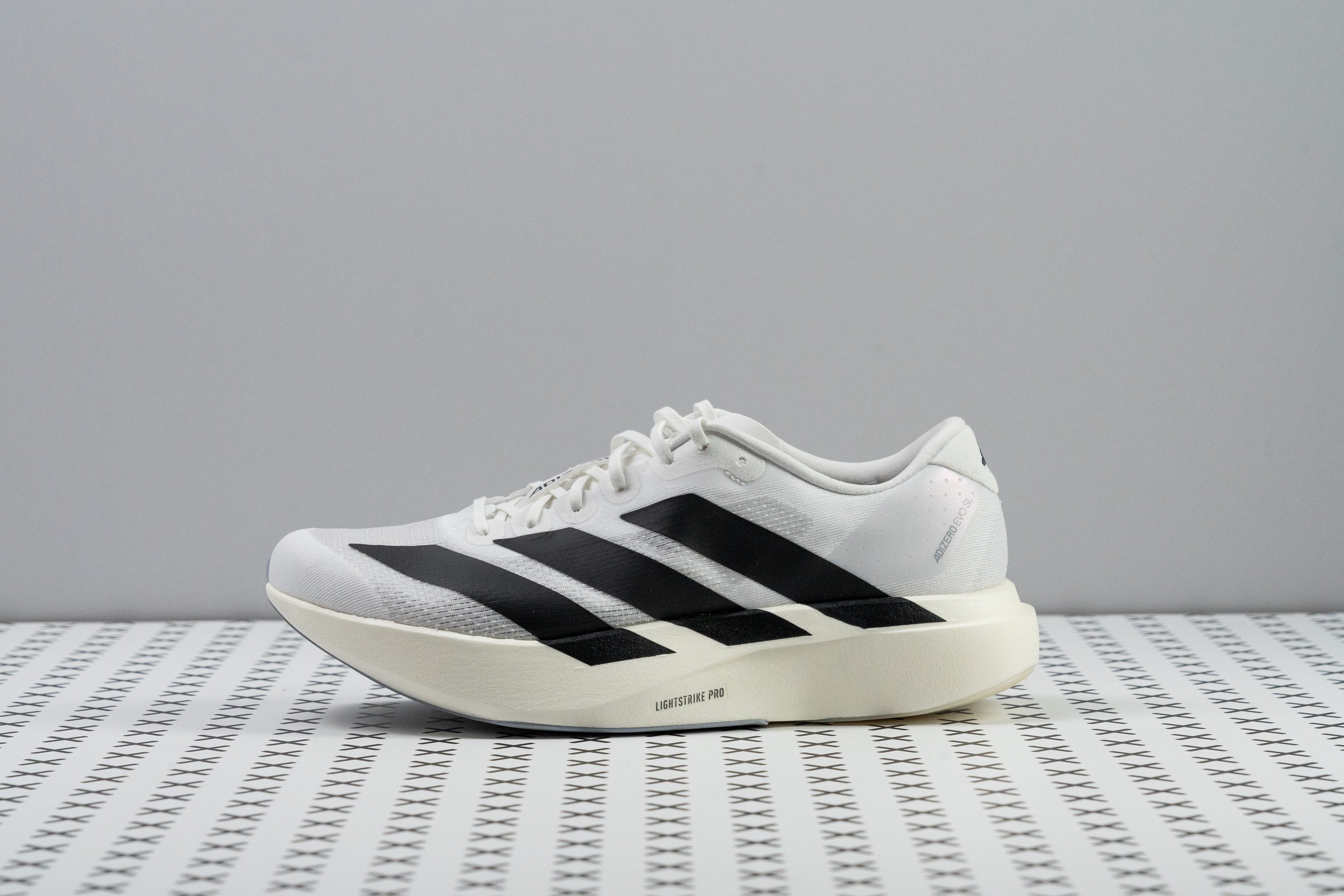
While the EVO SL uses the same foam as the Adios Pro 3, the front rocker geometry shifts from 70% to 60%—same as the hypershoe Adios Pro Evo 1—initiating earlier for a more comfortable and natural experience at slower paces.
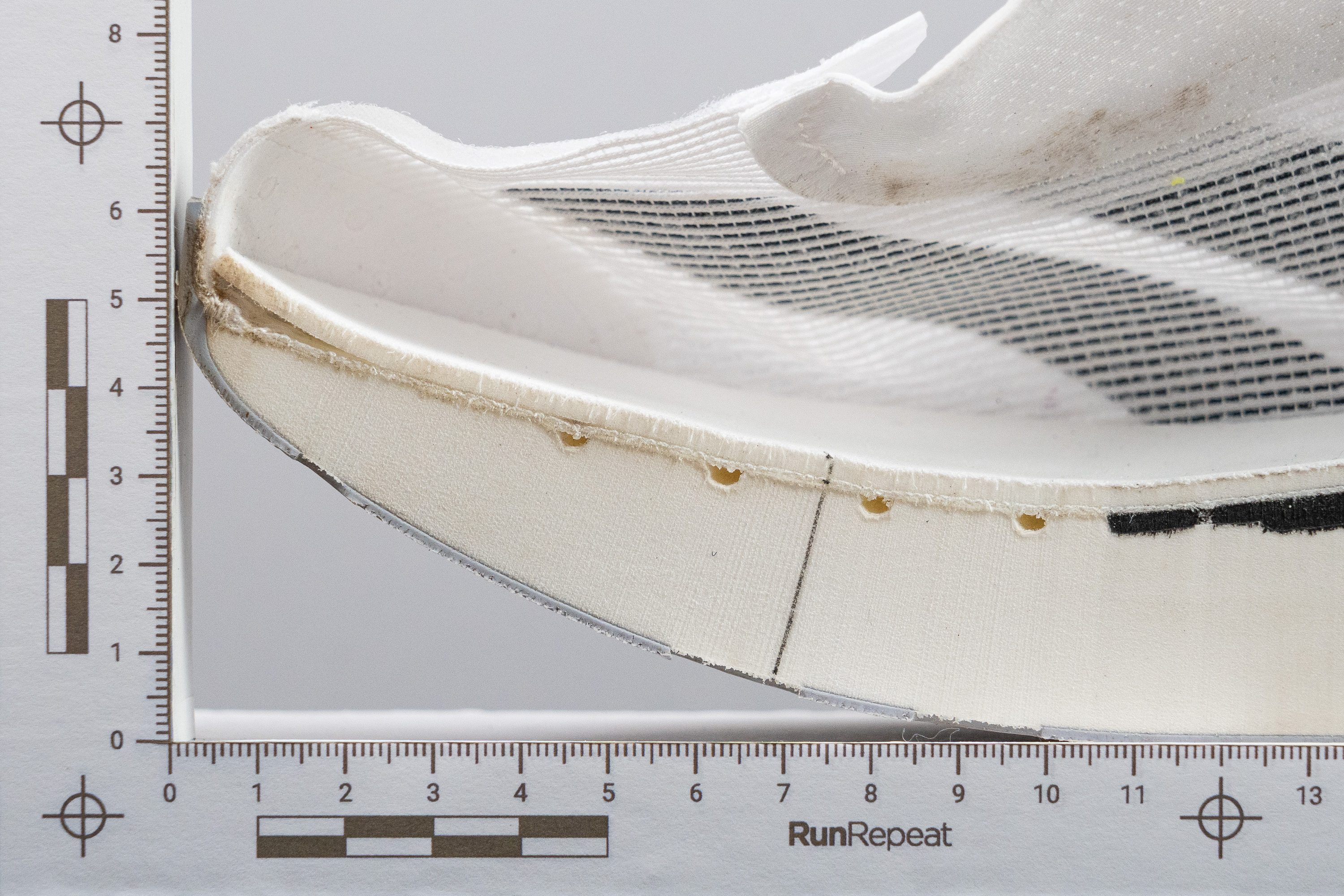
Lightstrike Pro
When Adidas first announced this shoe, it surprised everyone—especially because they claimed the Lightstrike Pro foam was exactly the same used in the Adidas Adizero Adios Pro 3, their high-end marathon racer. That’s quite rare in a £150 shoe!
Here’s why: some brands engage in what we see as borderline dark marketing. Take FuelCell from New Balance as an example: in the Rebel v4, it’s 20% PEBA and 80% EVA, resulting in good-but-not-great energy return. But in the Elite v4, it’s 100% PEBA—making it incredibly bouncy and responsive.
Yet both shoes carry the same “FuelCell” branding, and most runners don’t realise they’re getting vastly different foams. That’s where we step in.
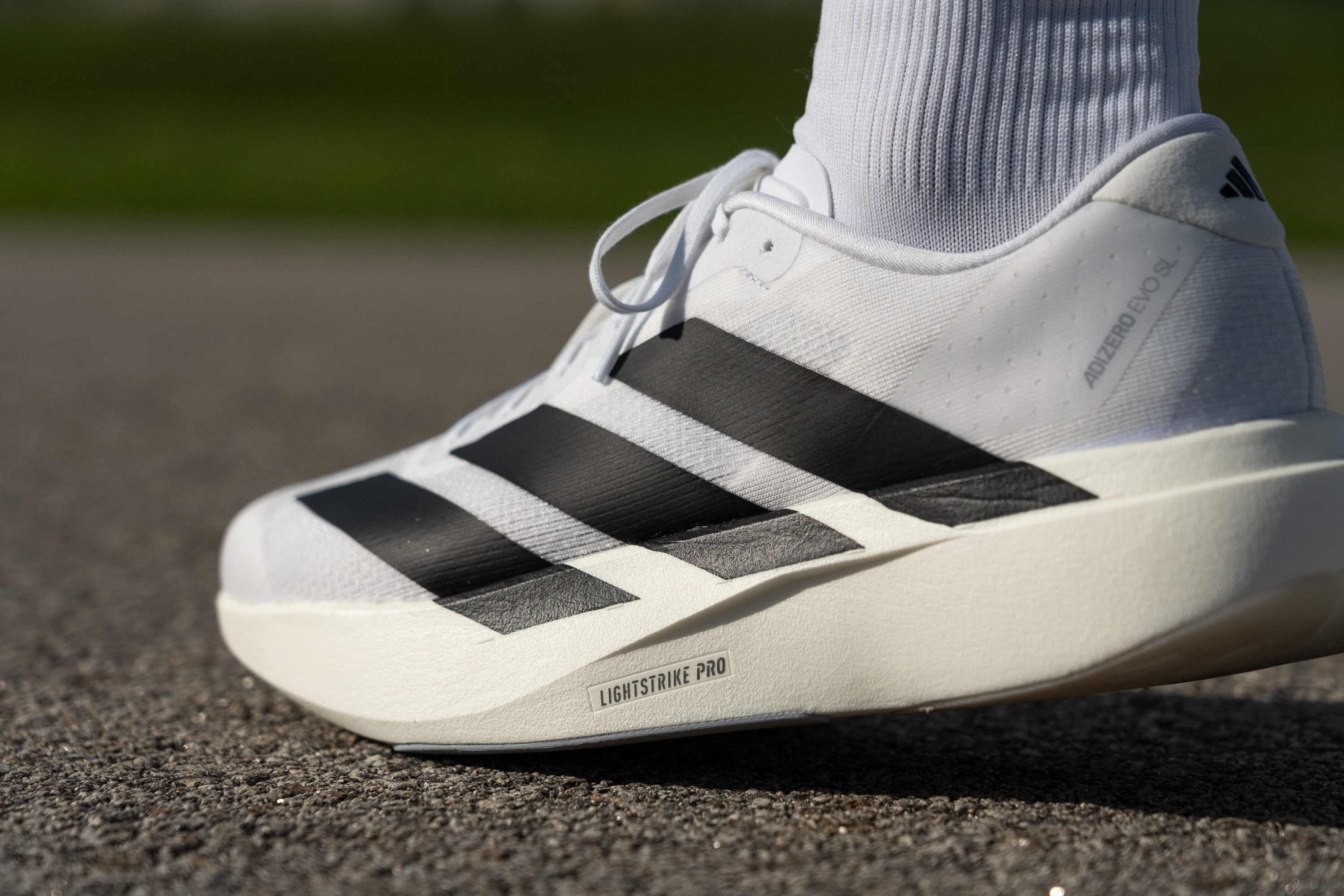
When we got the EVO SL—despite its extremely limited release—we wasted no time. Cutting a chunk of foam and examining it under the microscope, we confirmed it’s the same state-of-the-art Lightstrike Pro found in the Adios Pro 3, offering amazing durability and energy return. The minor differences between the two images are because of the shelf life of our Adios Pro 3 pair and its usage.
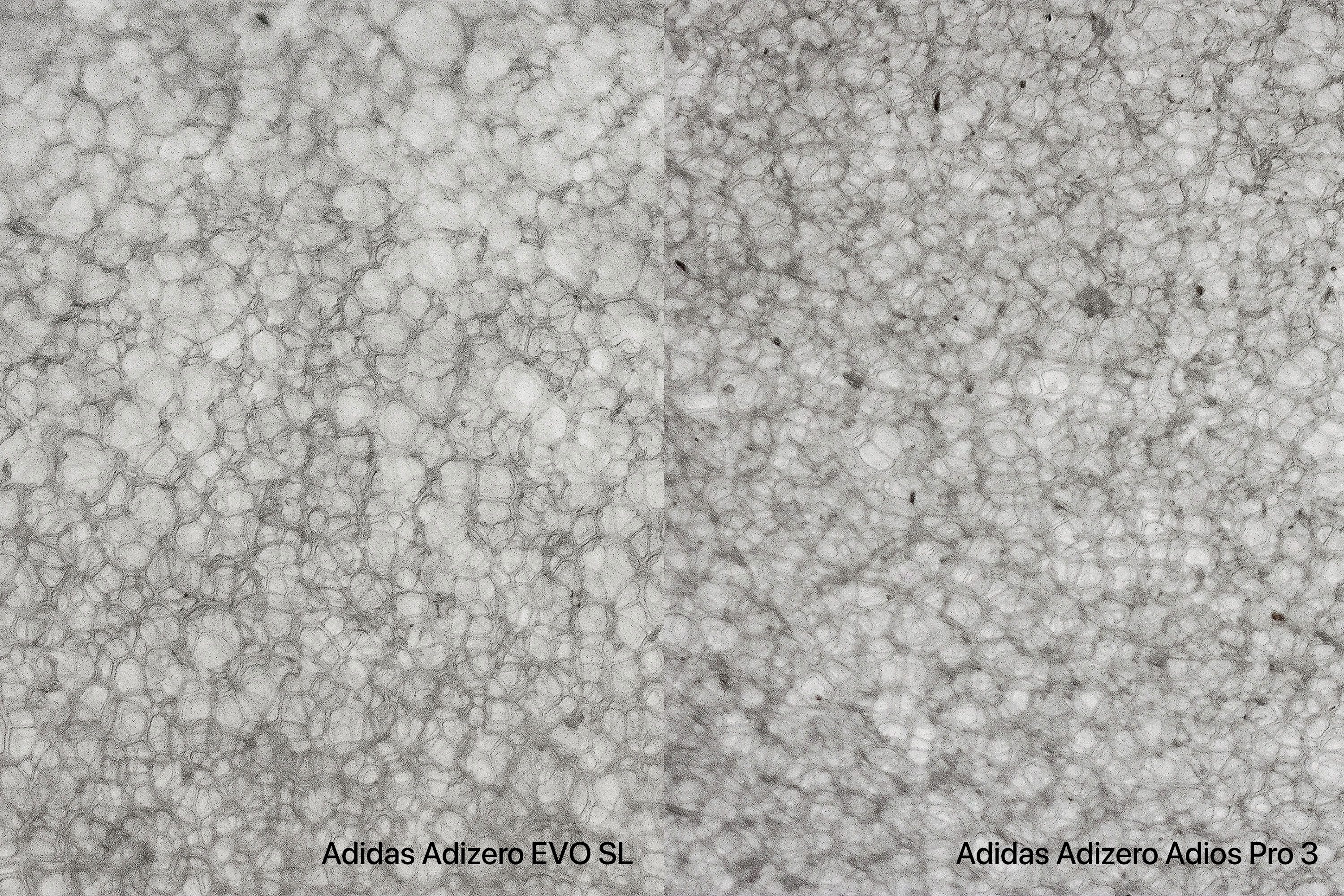
Plate
One of the unique features of the EVO SL is its plate-free design—an interesting choice that we found enhances versatility, making it suitable for a wide range of paces, from easy runs to track intervals.
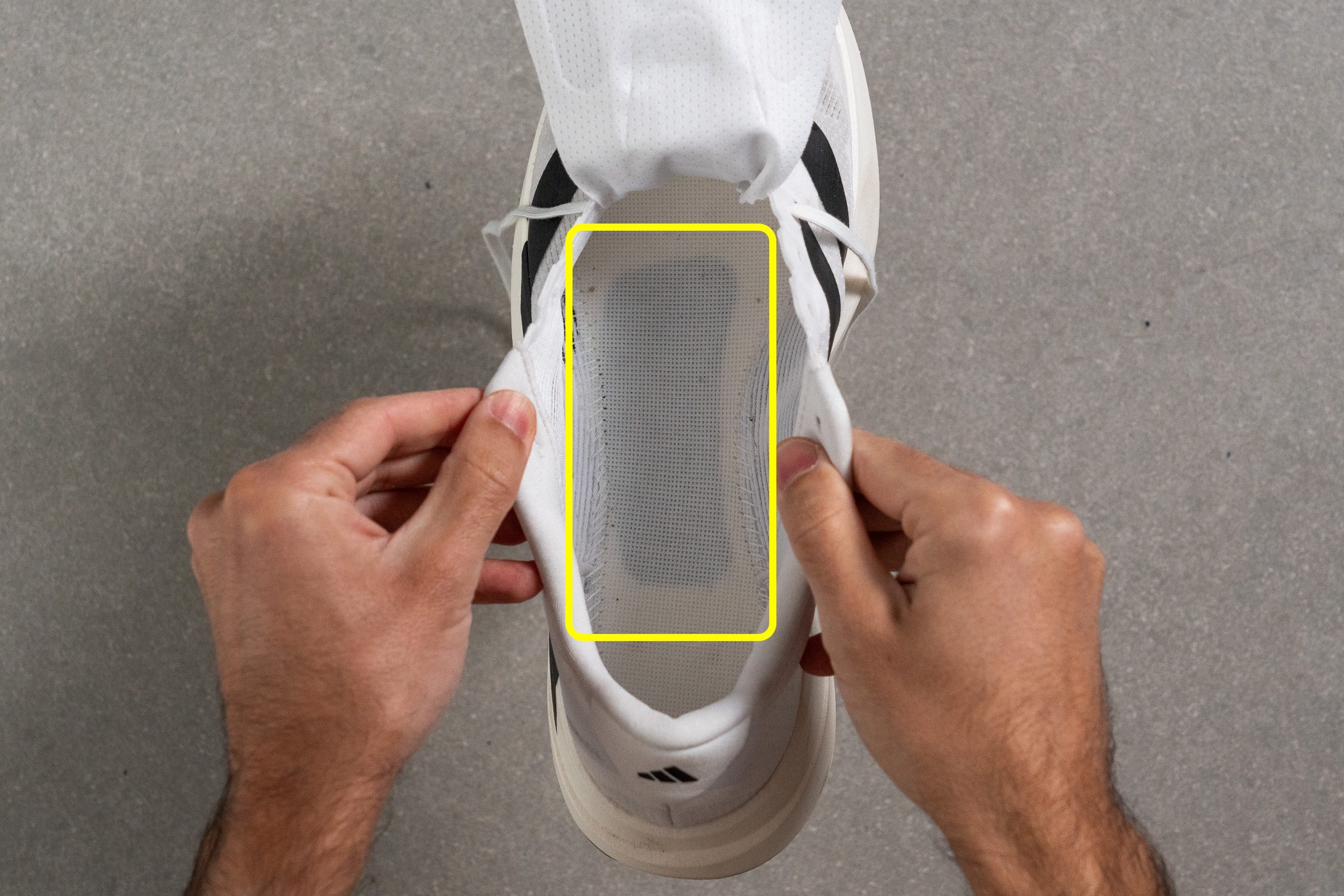
However, we discovered a plastic shank embedded in the midfoot, offering just enough stability to balance the ride of the full-length, ultra-bouncy foam. It’s similar to Nike’s Streakfly design but positioned closer to the foot.
Size and fit
Size
Adidas Adizero EVO SL fits true to size (768 votes).
Width / Fit
The EVO SL borrows design elements from both the EVO 1 and the Adios Pro 3, depending on the feature. In our view, the fit clearly reflects inspiration from the latter, despite resembling the former.
After making a lovely green jelly, we discovered that the widest part of the shoe measured an impressive 97.5 mm—wider than most daily trainers.
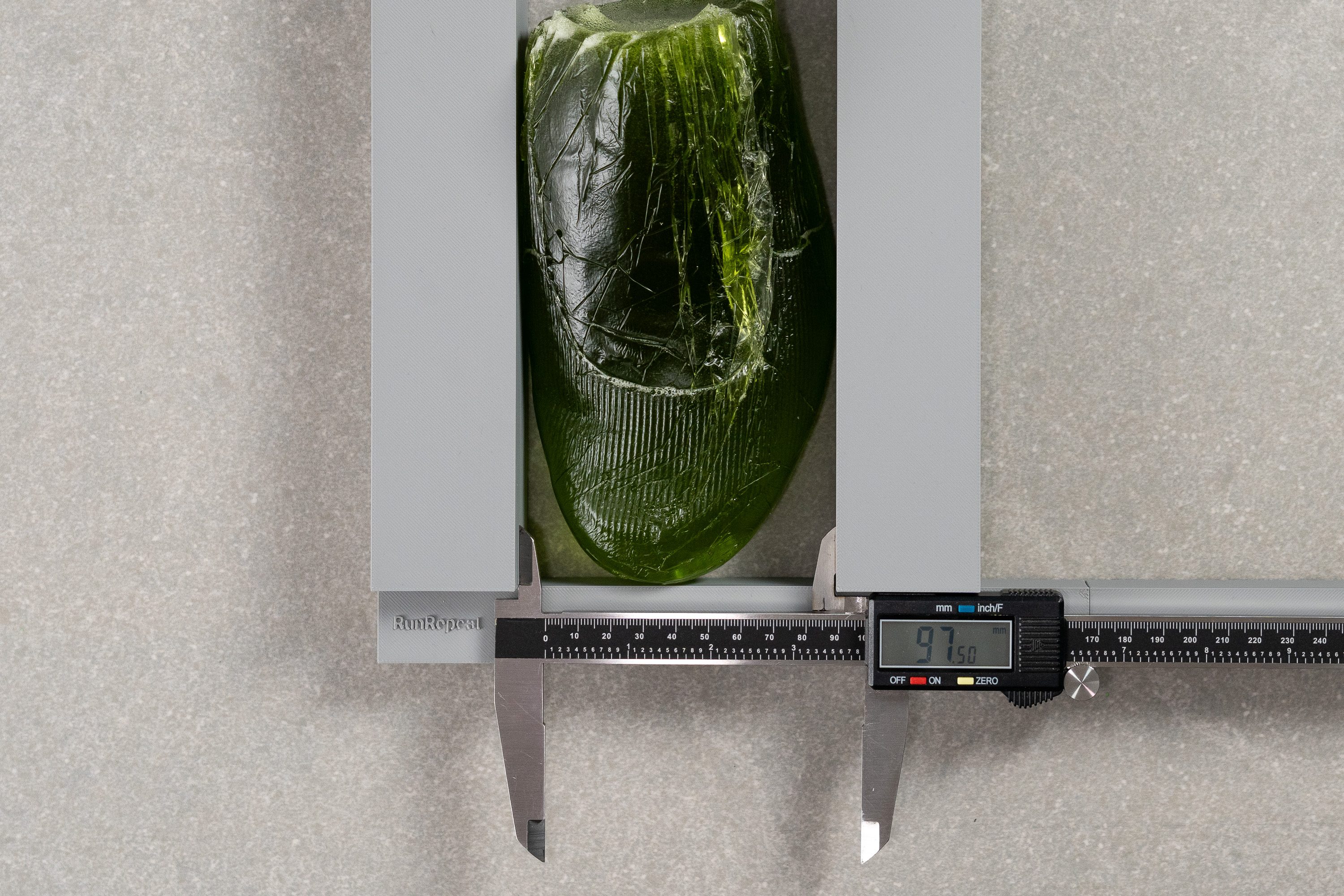
| Adizero EVO SL | 97.5 mm |
| Average | 95.1 mm |
Toebox width
But not everyone will feel an expansive fit on the EVO SL. While we found the ball of the foot area wider than expected, the toebox tapers sharply to 71.6 mm—offering a racer-inspired, performance-focused fit that may divide opinions.
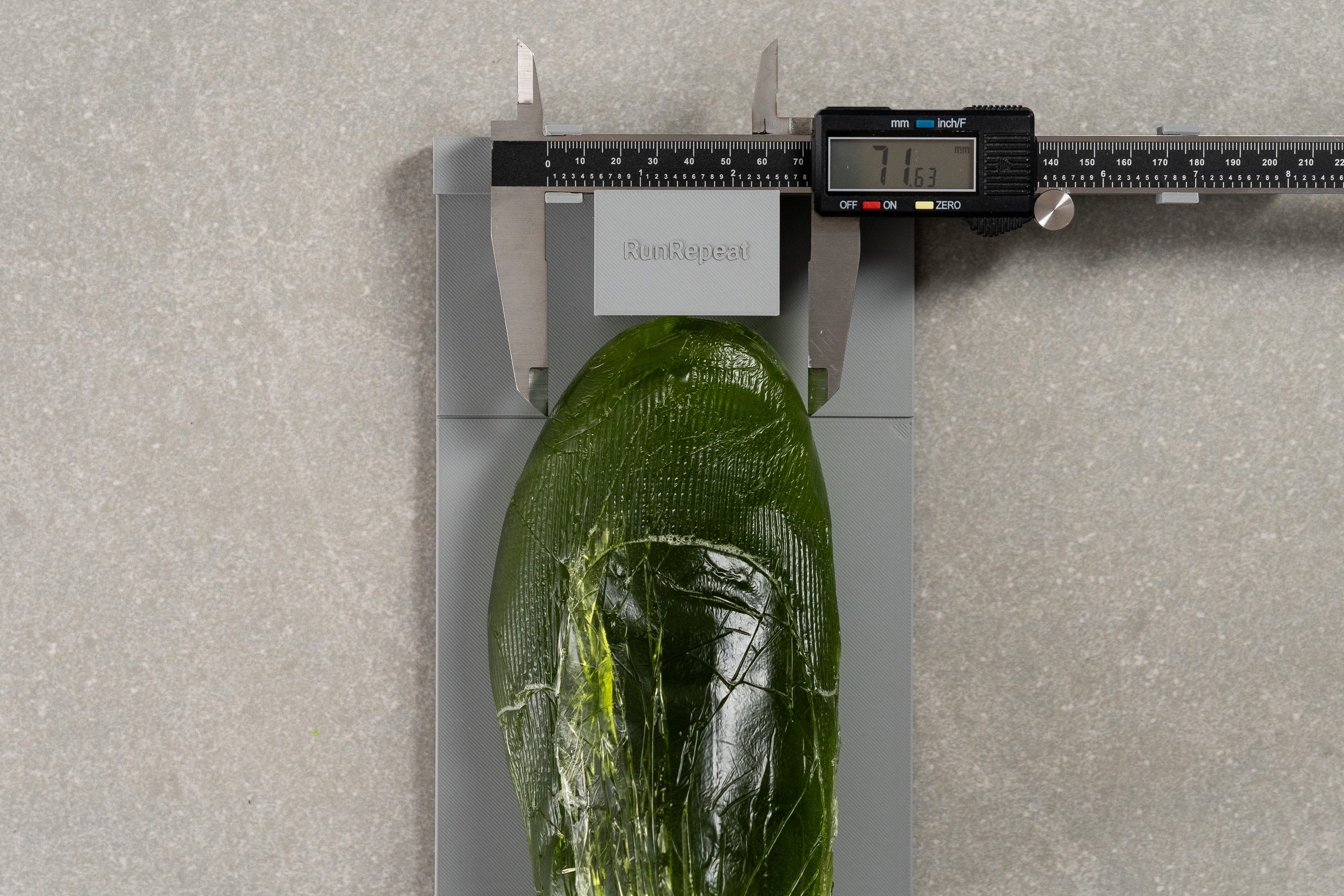
| Adizero EVO SL | 71.6 mm |
| Average | 73.2 mm |
Toebox height
The toebox height measures a satisfactory 28.1 mm. While the material isn’t super stretchy, we believe the ample height provides enough room to prevent cramped feelings for most runners. In our view, this balance works well for this shoe.
And since this super-versatile shoe leans more toward speed than leisurely runs, a loose fit would’ve been a major drawback.
| Adizero EVO SL | 28.1 mm |
| Average | 27.1 mm |
Toebox volume
The volume is not generous—expected in any Adizero shoe—so those who often point their toes upward might feel some restriction.
However, the mesh has some stretch and it's pliable. Therefore shouldn't cause any black toenails.
Traction / Grip
Traction test
We found that the EVO SL delivered solid grip during our test, though it lags slightly behind other shoes with Continental rubber. Still, we were satisfied, as it ensures dependable traction on both dry pavement and rain-slicked surfaces.
| Adizero EVO SL | 0.40 |
| Average | 0.48 |
Outsole design
The rubber coverage is impressive for the lightweight design of this shoe, and it instantly reminded us of the Adios Pro 3. It features a Continental forefoot patch with multiple cutouts, complemented by two Clear Rubber pieces that provide durability to the heel.

Flexibility / Stiffness
What makes this shoe incredibly versatile is its lack of a full-length plate, giving it a daily-trainer-like flexibility (9.8N) that we found perfect for easy runs.
It also works brilliantly as a casual sneaker—thanks to its clean design, which we think will appeal to many. In fact, Adidas surprisingly marketed this shoe partly as a lifestyle sneaker, which we found unexpected given its performance-focused Lightstrike Pro midsole and the minimal rubber coverage on the outsole. Sure, it looks extremely cool, but...

| Adizero EVO SL | 9.8N |
| Average | 15.3N |
Weight
The EVO SL packs so many standout features that its weight—impressive by any standard—feels just as expected here. At 7.9 oz (223g), it’s insanely lightweight for its size, only slightly heavier than racing shoes but offering a more comfort-driven upper.
We would have preferred a slightly heavier design, perhaps around 8.5 oz (240g), if it meant a better tongue, which we found to be the shoe’s weakest element. Still, Adidas did an A+ job with the EVO SL. Again.
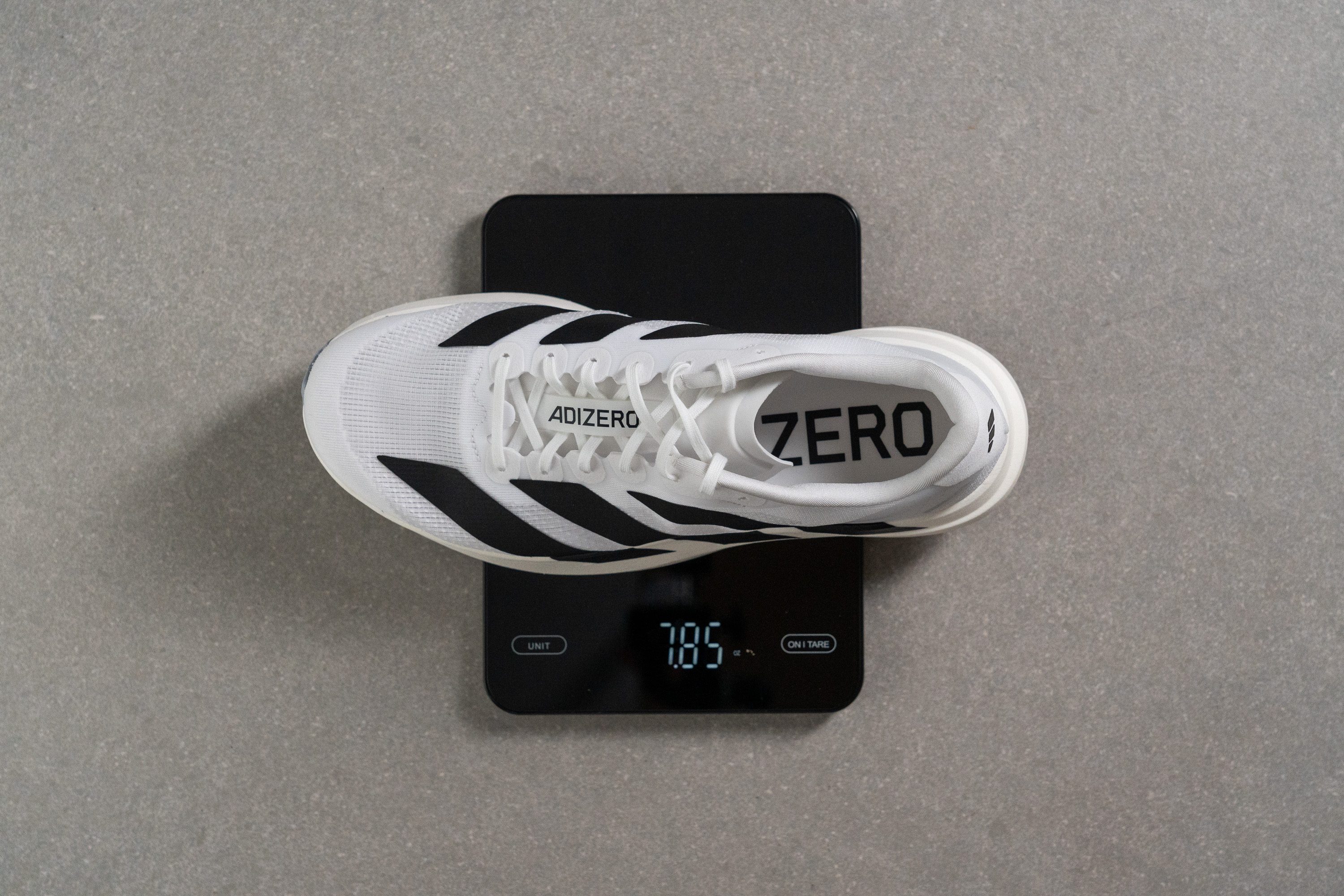
| Adizero EVO SL | 7.9 oz (223g) |
| Average | 9.3 oz (264g) |
Breathability
When we unboxed the much-anticipated Adizero EVO SL in the lab, it became immediately clear that breathability was a standout feature.
The engineered mesh upper is almost see-through, and when we tested airflow with smoke, it flowed effortlessly out of the toebox. This remarkable ventilation earned the shoe a perfect 5/5 in our tests.
We then placed the upper over a bright LED light, which revealed how Adidas strategically optimised airflow. The toebox and lateral areas feature exceptionally thin mesh for ventilation, while other sections use thicker material to provide stability and structure during runs. And yes, the three stripes are more than just for bold looks—they also serve as a supportive element.

Next, we zoomed in with our microscope to examine the intricate details of the mesh. The only advice we’d give here is that runners in freezing-cold climates should really pair this shoe with thicker socks.

Hundreds of micro-ventilation holes are evenly distributed, though the design is fairly straightforward. In fact, we are pretty sure that Adidas saved costs in the upper to deliver the EVO SL at such an appealing price.
Padding is minimal, as expected from a sub-8-oz shoe, but sufficient for daily training if comfort isn’t your top priority. And let's be honest—if you're seeking a luxurious and plush upper, the EVO SL won’t meet your needs. We think that bulkier models like the ASICS Gel Nimbus 26 may be a better fit for runners prioritising comfort over performance.
| Adizero EVO SL | 5 |
| Average | 3.7 |
Stability
Lateral stability test
The Adizero EVO SL isn’t a stability shoe, making it only suited for neutral runners. However, for those who don’t need extra support, we found it delivers a remarkably steady and confidence-boosting ride.
Despite lacking a plate and relying on a full-length, energy-loaded Lightstrike Pro midsole paired with a small midfoot shank, we never wished for oversized sidewalls or exaggerated sole flare like in those bulky supertrainers. Its streamlined dimensions offer a refreshing, fun running experience.
Torsional rigidity
In this same lab review, we explained that the Adizero EVO SL includes a midfoot shank acting as a subtle stabilizer, adding a touch of rigidity. That's why it earned a 4/5—higher than the average 2 or 3 we usually see in daily trainers.
| Adizero EVO SL | 4 |
| Average | 3.5 |
Heel counter stiffness
Unlike most Adizero racing shoes with ultra-flexible heel counters, Adidas opted for the same cardboard insert used in their training models. This upgrade adds notable structure and support, earning a reasonable 3/5 in our evaluation.
| Adizero EVO SL | 3 |
| Average | 2.9 |
Midsole width - forefoot
We hinted just a few tests ago about the dimensions of this midsole—standing in stark contrast to the oversized designs dominating today’s running shoe market. Here’s the evidence to back it up.
Our first measurement delivered a forefoot width of 116.3 mm, a figure that we felt balanced and stable underfoot. This is largely thanks to the midsole's balanced softness, which effectively minimises unwanted lateral forces. While plush midsoles might feel more luxurious, we believe the EVO SL performs much better without one.
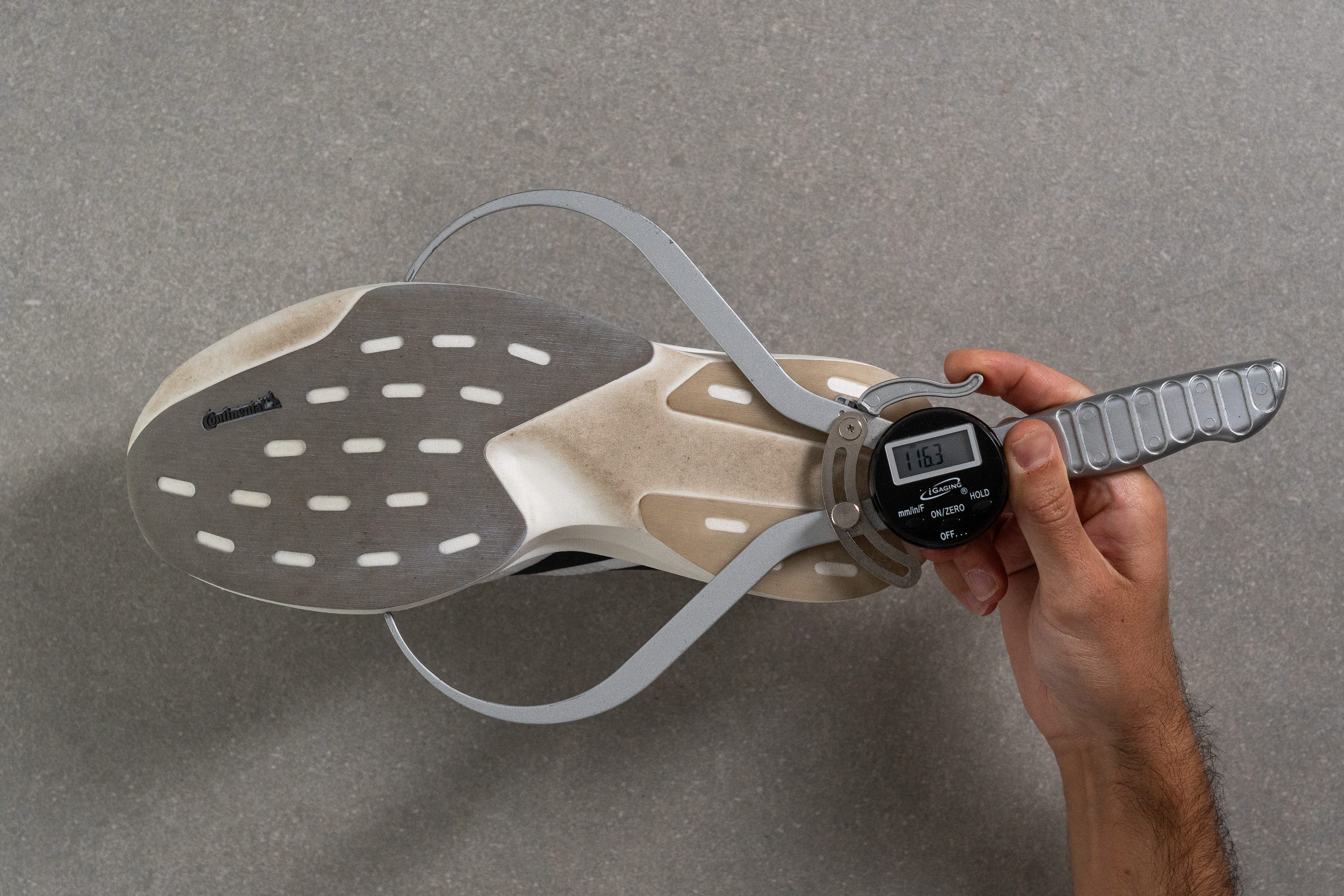
| Adizero EVO SL | 116.3 mm |
| Average | 114.4 mm |
Midsole width - heel
The heel showcases classic Adizero DNA, featuring a distinctly narrow design (87.3 mm) for its substantial stack height. As we’ve already mentioned, this shoe isn’t ideal for non-neutral runners, and pronounced heel strikers should use also seek running shoes like the ASICS Novablast 4 or the Hoka Mach 6.
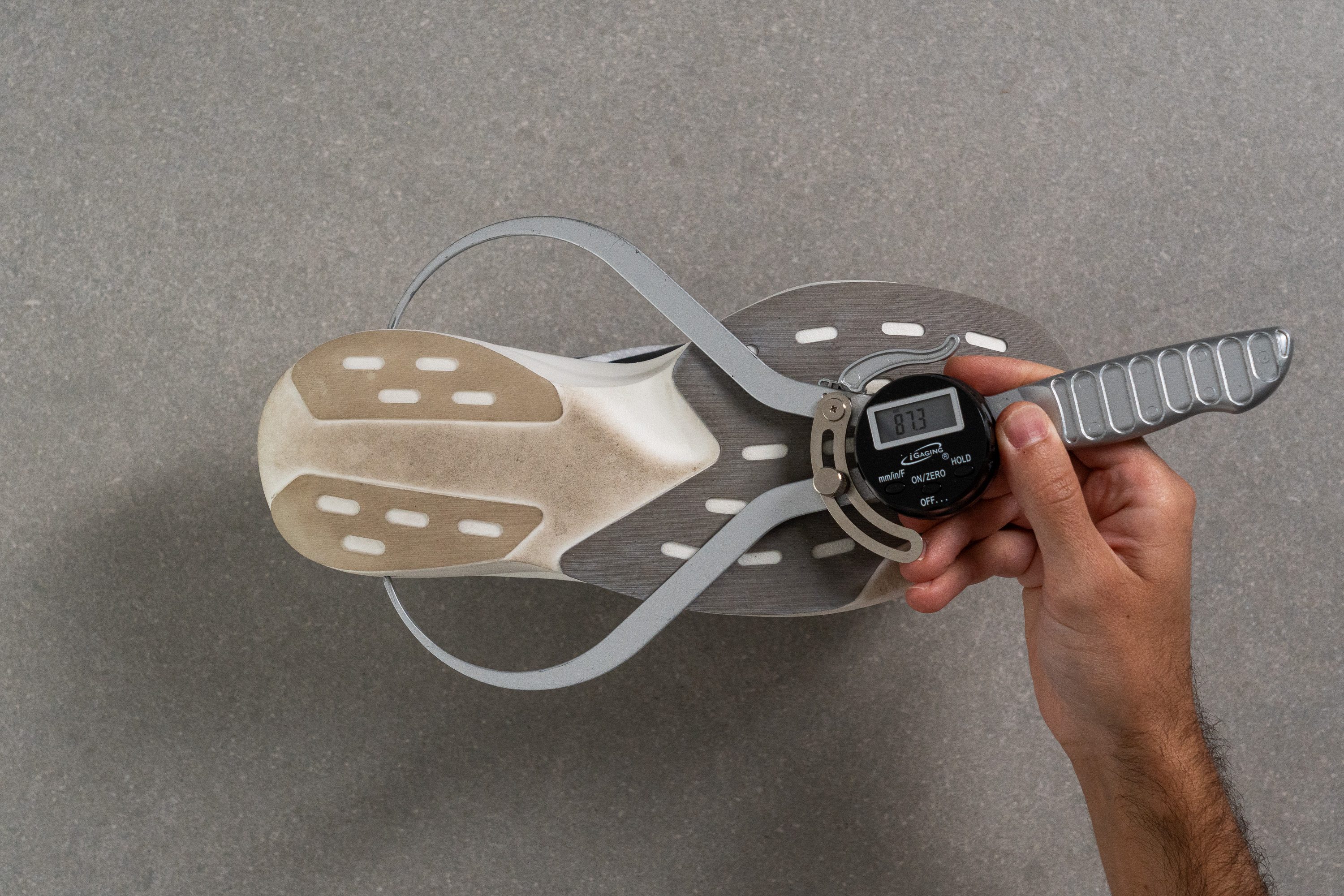
| Adizero EVO SL | 87.3 mm |
| Average | 90.7 mm |
Heel bevel
Adidas is renowned in the running shoe world for its bold heel bevels, designed to help heel strikers with mild stability issues toward a more centred stride.
In our experience, while the aggressive design might seem excessive, it feels surprisingly natural during runs—just like other Adidas models. Even workhorse trainers like the Supernova Prima incorporate a similar angled heel, encouraging a smoother transition from heel to midfoot by slightly guiding the foot inward.
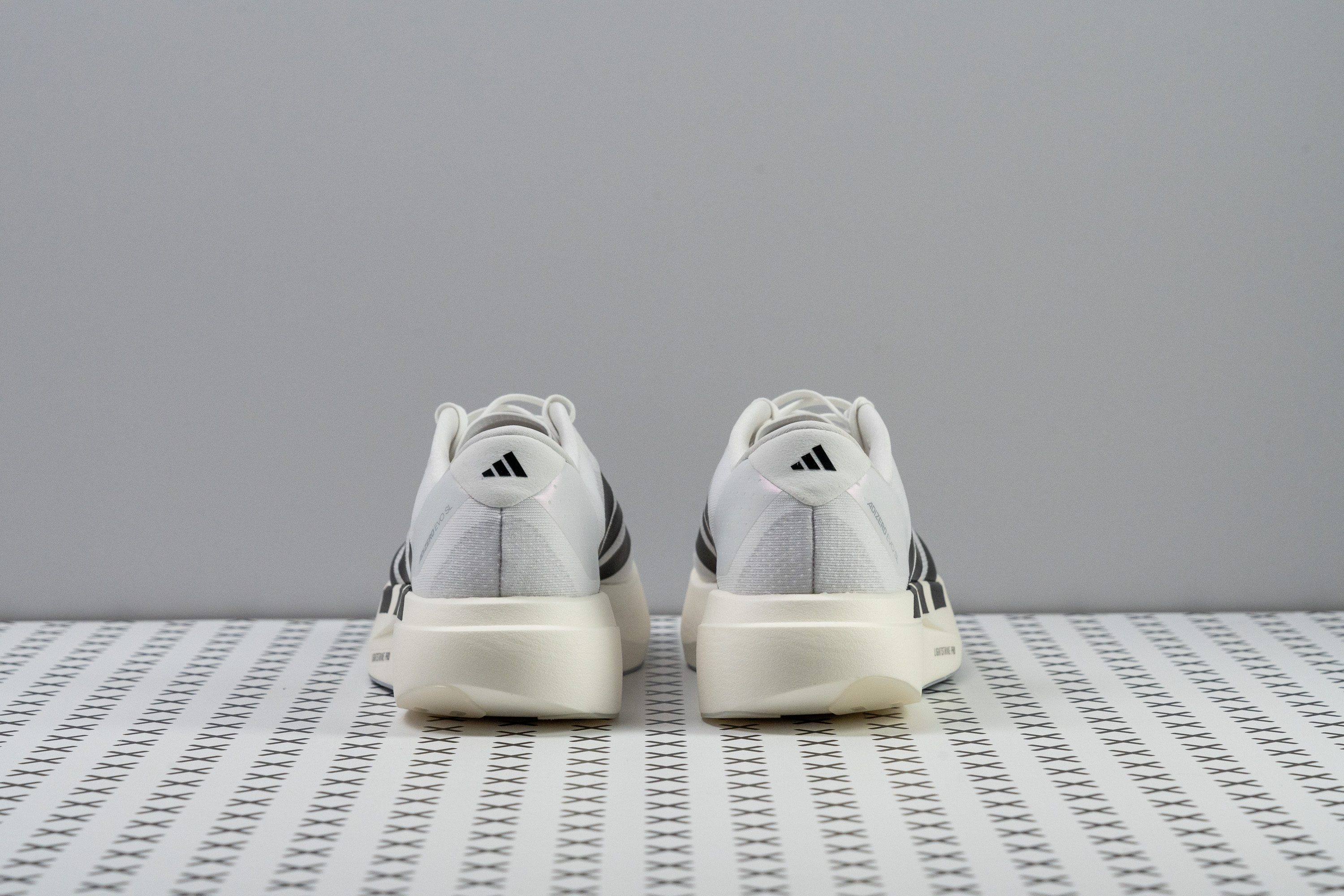
Durability
Toebox durability
Looking at the upper, we were immediately concerned about durability—and our testing confirmed it with a 1/5 score. In our view, this result stems from the ultra-breathable, single-layer mesh construction.
However, we discovered that the material is on the rough side, making it a bit tougher to damage with the toenails than softer, knit uppers.

| Adizero EVO SL | 1 |
| Average | 2.6 |
Heel padding durability
The heel padding area passed our Dremel test with ease, thanks to its scarce padding and wear-resistant lining—especially compared to average daily trainers.
In fact, the EVO SL earned a spot in the elite group of running shoes that achieved a perfect 5/5, our highest score in this durability test. From our perspective, there are absolutely no wear concerns in this area, so let's move on!
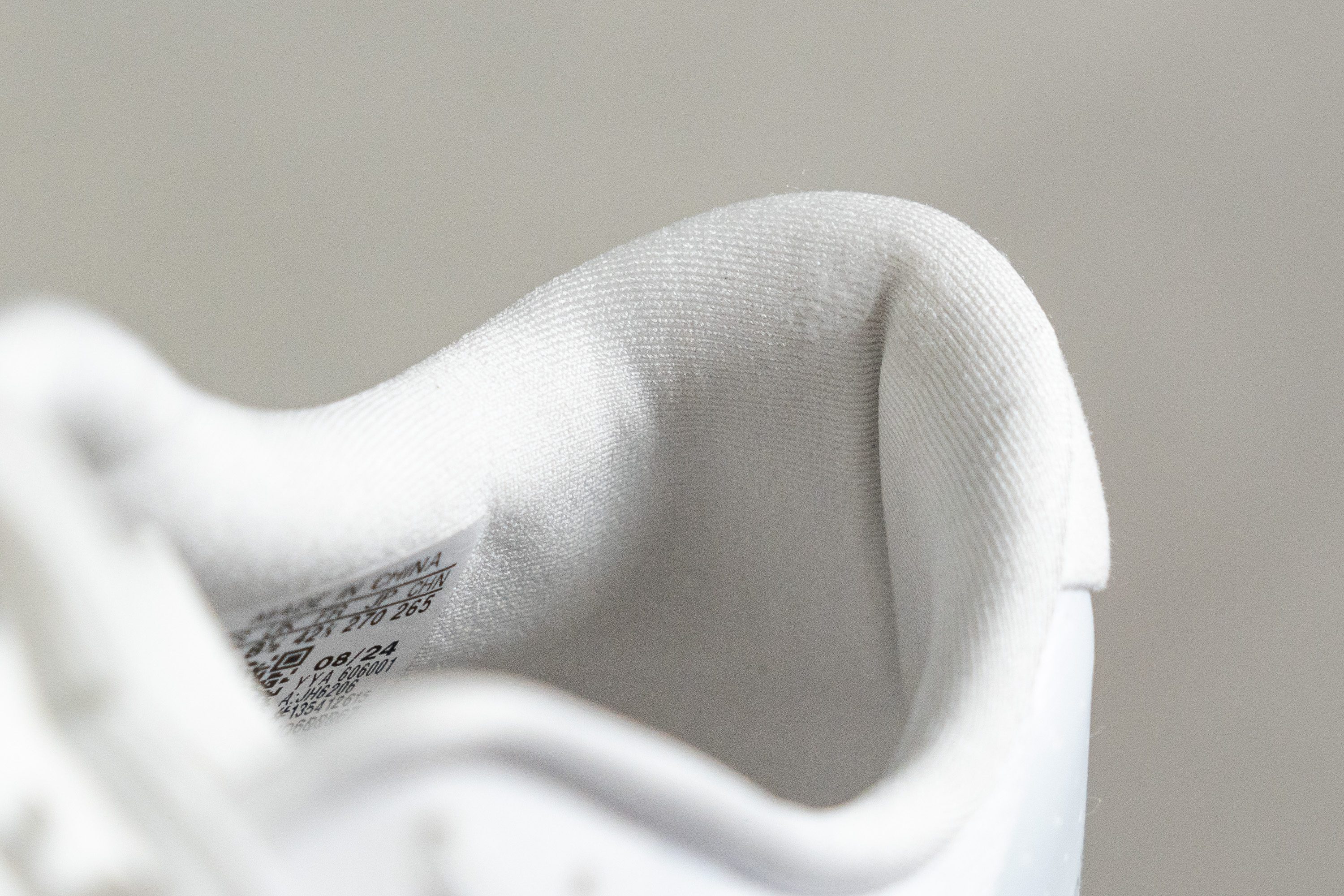
| Adizero EVO SL | 5 |
| Average | 3.4 |
Outsole hardness
The rubber coverage is impressive for the lightweight design of this shoe. It features a Continental forefoot patch with multiple cutouts, complemented by two Clear Rubber pieces that provide durability to the heel.

For our primary test, we focused on the heel, as it’s typically the most wear-prone area. The reading came in at 57.1 HC—a remarkably soft result. In our experience, this was expected since Adidas uses the same high-grip compound in their racing shoes.
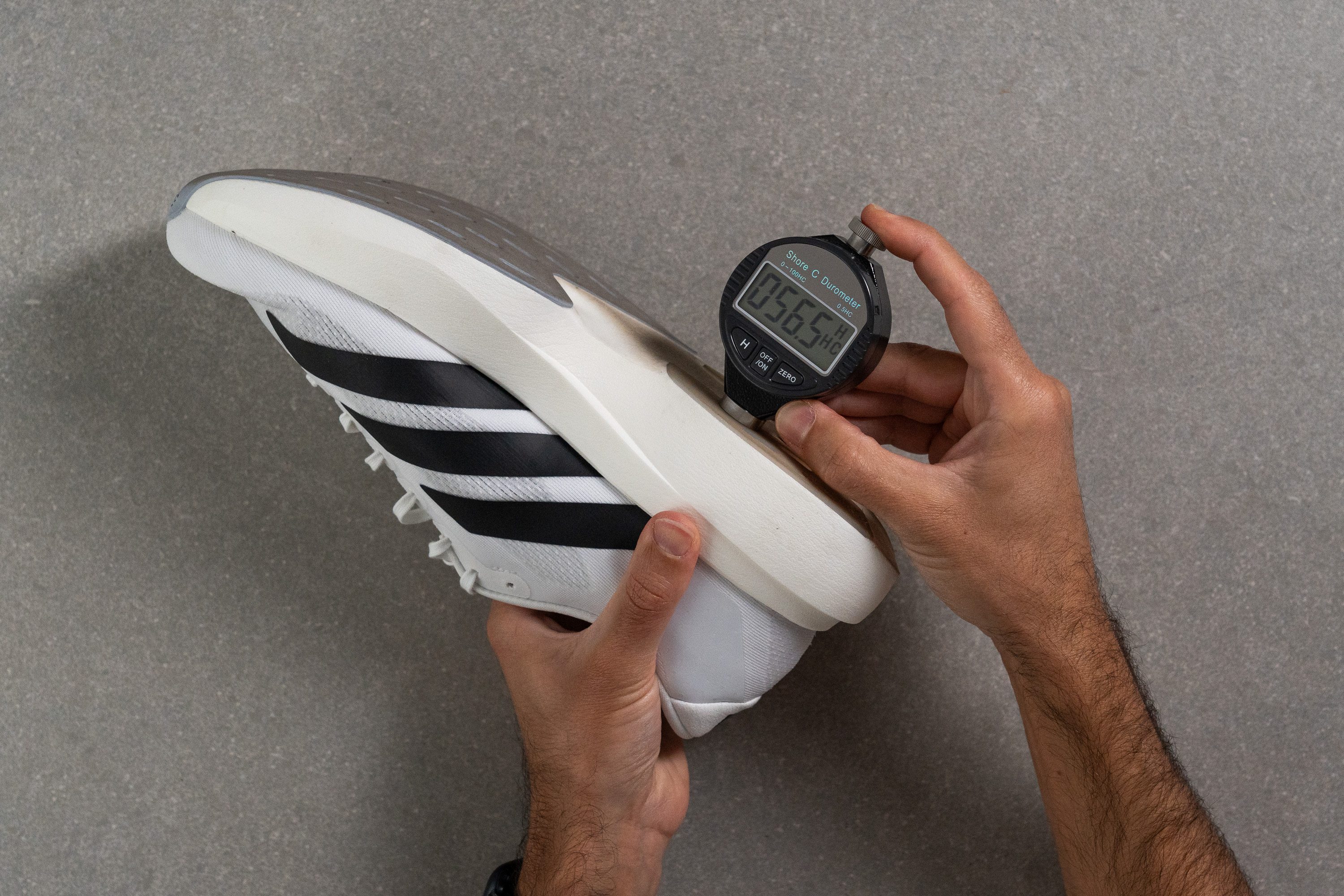
| Adizero EVO SL | 57.1 HC |
| Average | 79.2 HC |
Outsole durability
Every time the durometer gives a low reading on the outsole, we fear potential wear issues—but that’s where testing comes in!
Adidas proved its mastery in crafting exceptionally durable road-running outsoles one more time, maybe only rivalling PUMA shoes featuring PumaGrip rubber. We measured minimal wear—just 0.6 mm—which confirmed that despite the thin layer, this outsole will last long enough to handle serious mileage.
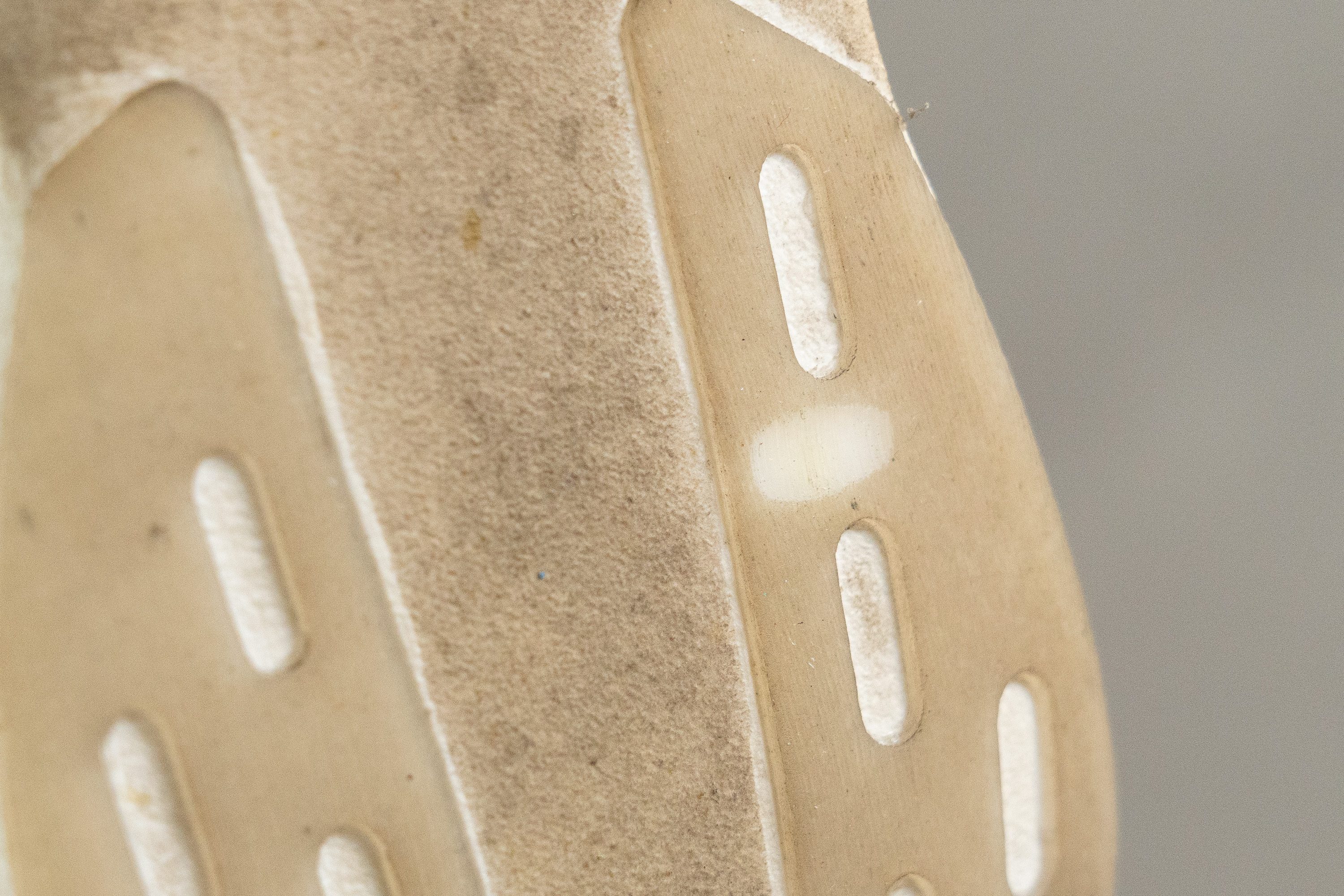
| Adizero EVO SL | 0.6 mm |
| Average | 1.1 mm |
Outsole thickness
Just by looking at the EVO SL, it’s clear that the shoe features an ultra-thin rubber layer. Our vernier callipers confirmed this impression with a reading of 1.6 mm—roughly half the thickness of most outsoles.
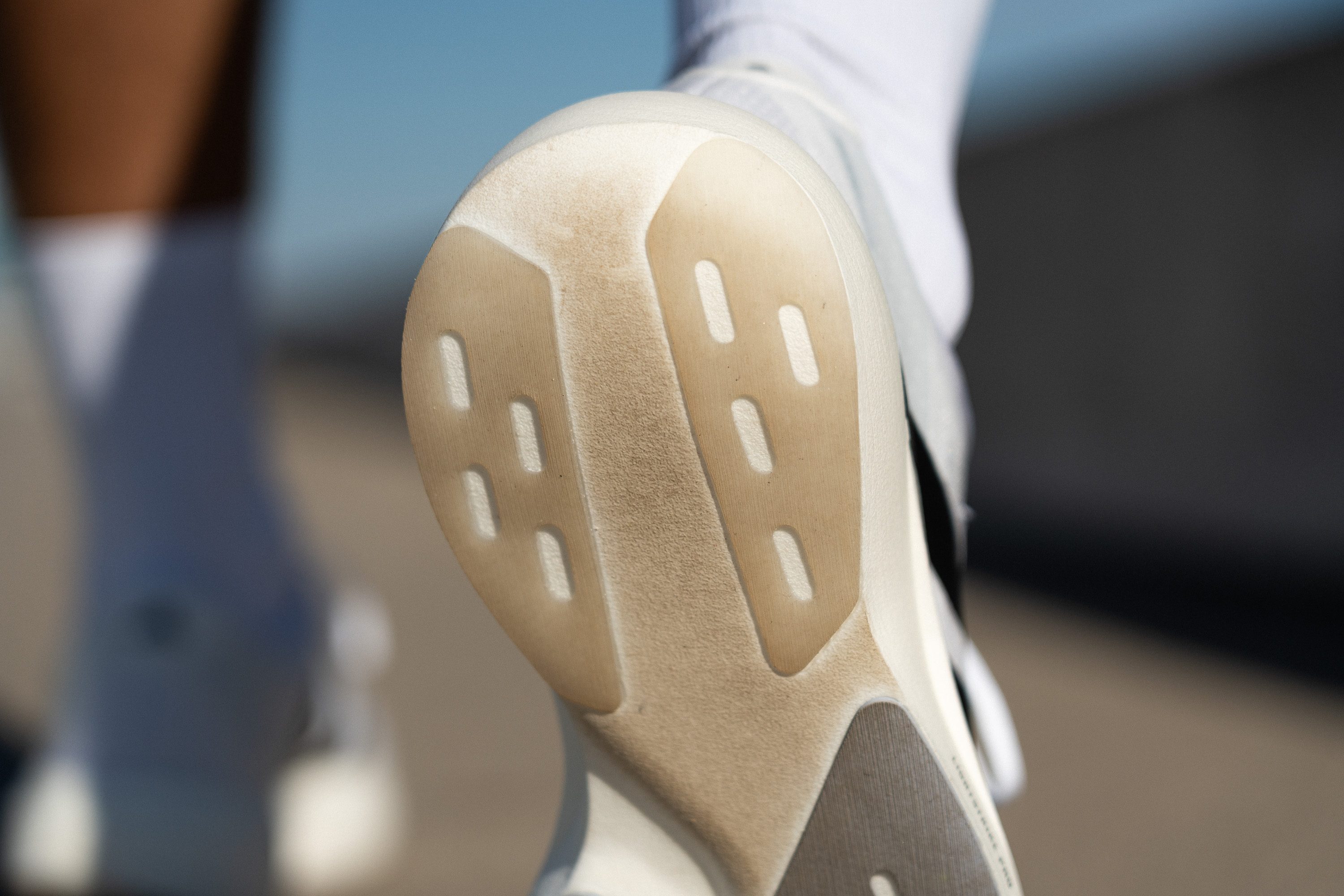
While durability concerns might arise despite the fantastic results of our previous test, we believe this minimalist design offers a key advantage besides its low weight.
The super-soft, razor-thin rubber creates an almost seamless connection between the responsive Lightstrike Pro foam and the ground, and that allowed us to enjoy a smiles-guaranteed, unfiltered running experience.
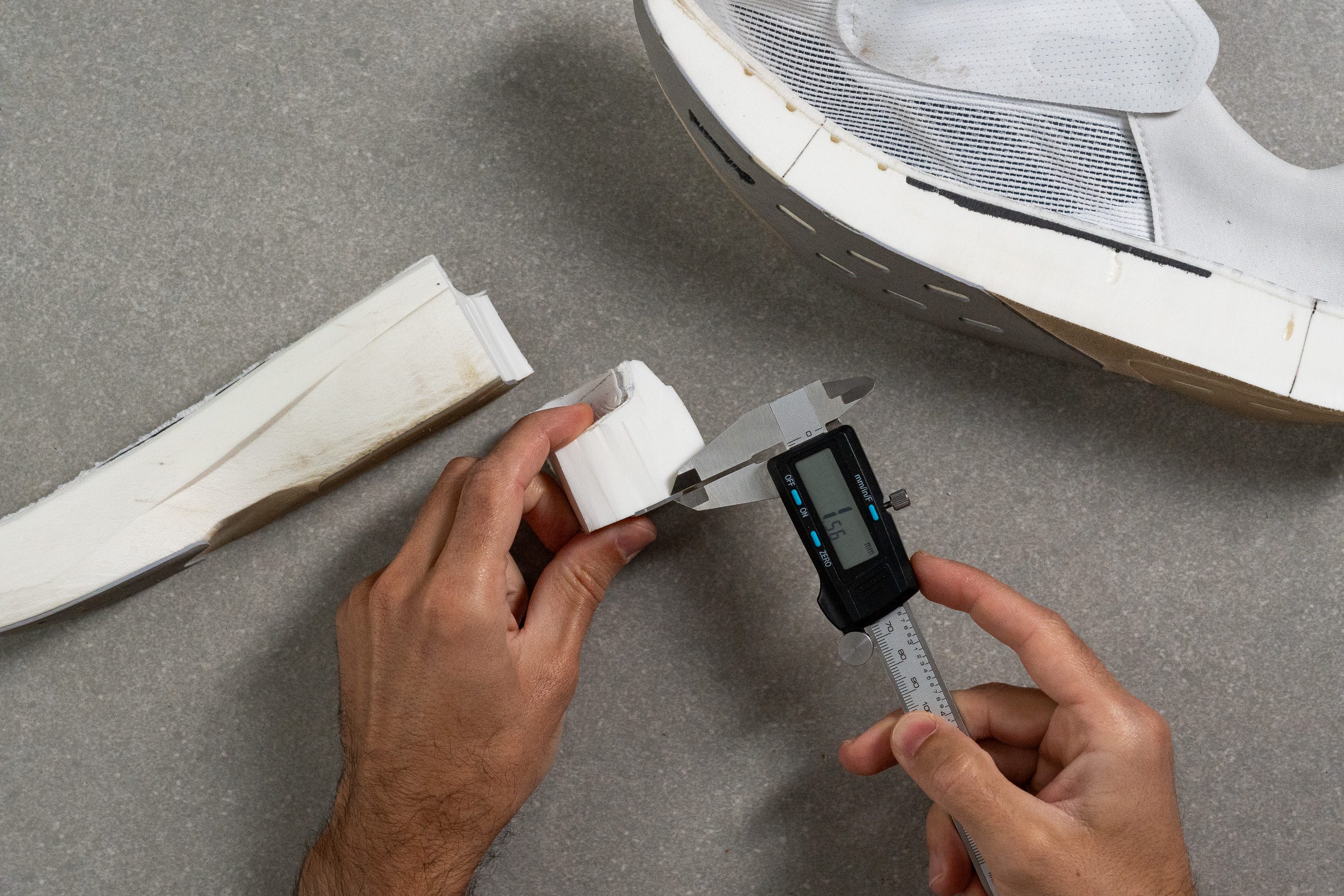
| Adizero EVO SL | 1.6 mm |
| Average | 3.2 mm |
Continental
Another unbelievable trait of the EVO SL for its price is that it uses Continental (Conti Winter) rubber, one of the best in the game by far, and not always present in similarly-priced Adidas shoes.

This premium rubber is only present in the front of the shoe, and it also comes in a soft formulation (59.5 HC) that ensures out-of-this-world grip.
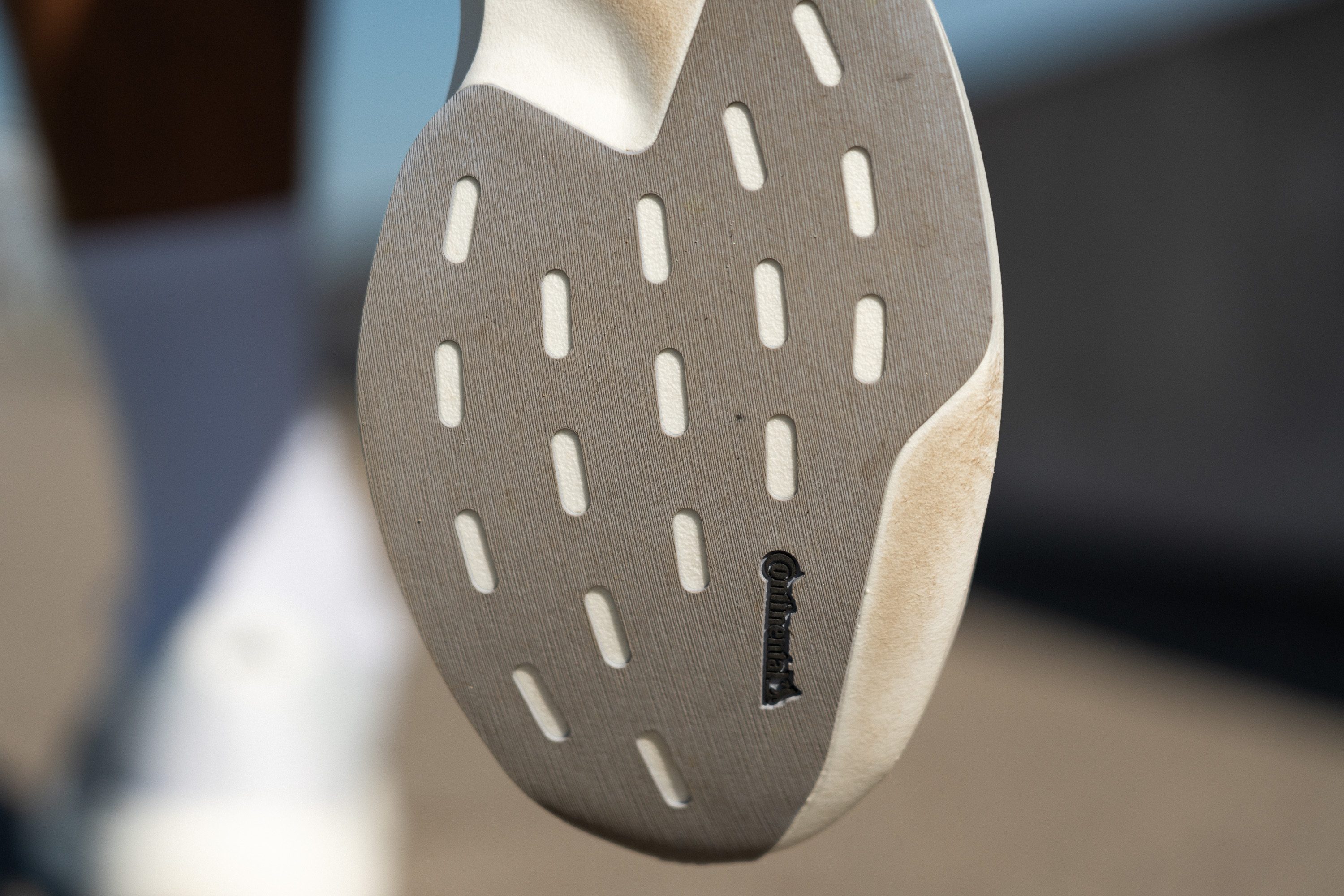
Misc
Insole thickness
While we often prefer thicker, comfort-focused insoles, we understand that this shoe prioritises maximising Lightstrike Pro, and the 2.4 mm thickness made perfect sense to us.
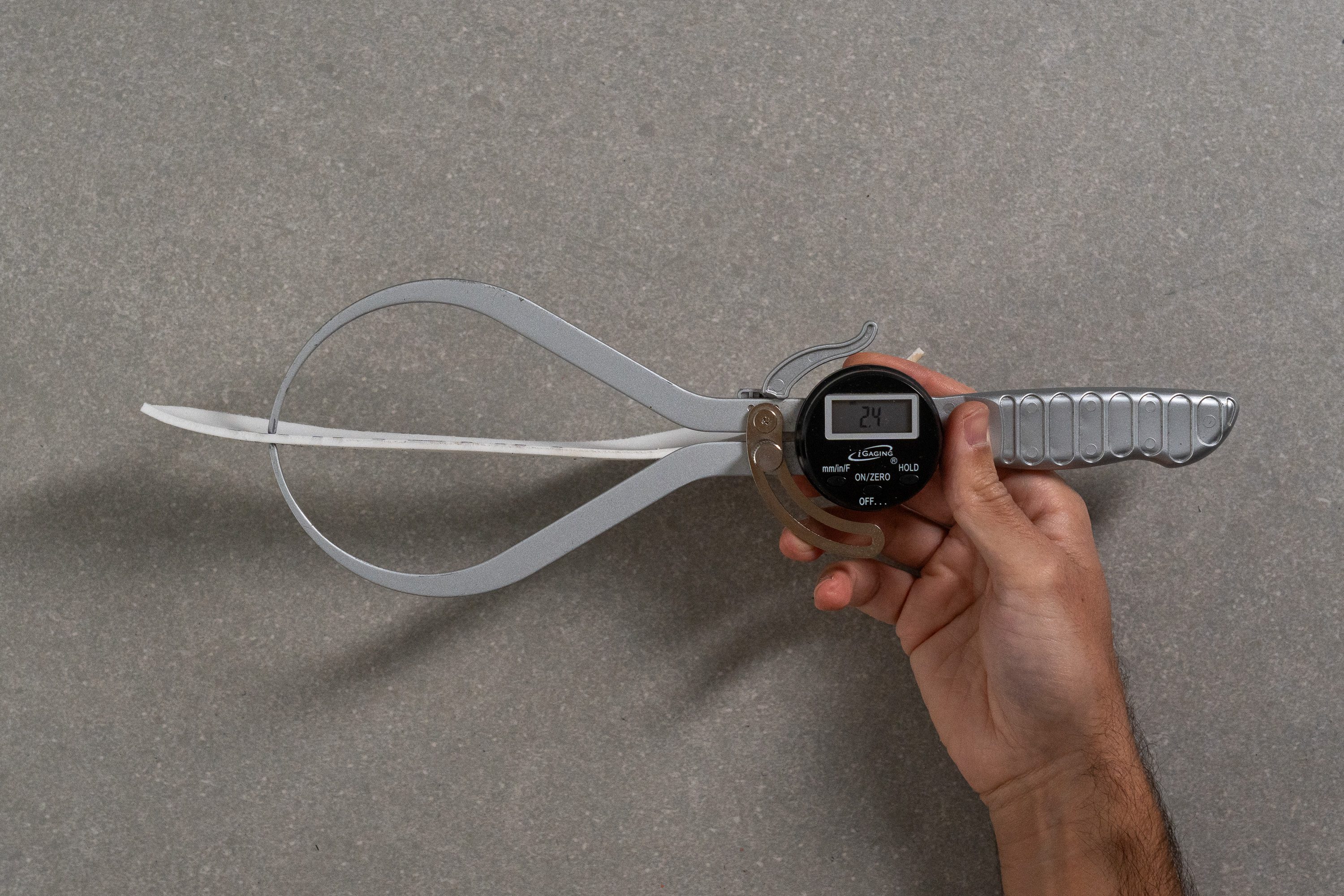
| Adizero EVO SL | 2.4 mm |
| Average | 4.5 mm |
Removable insole
You can remove the paper-thin insole, but the Adizero EVO SL isn’t very accommodating for third-party orthotics. The limited space inside the upper means most aftermarket footbeds, typically at least twice as thick, could significantly reduce the available room.
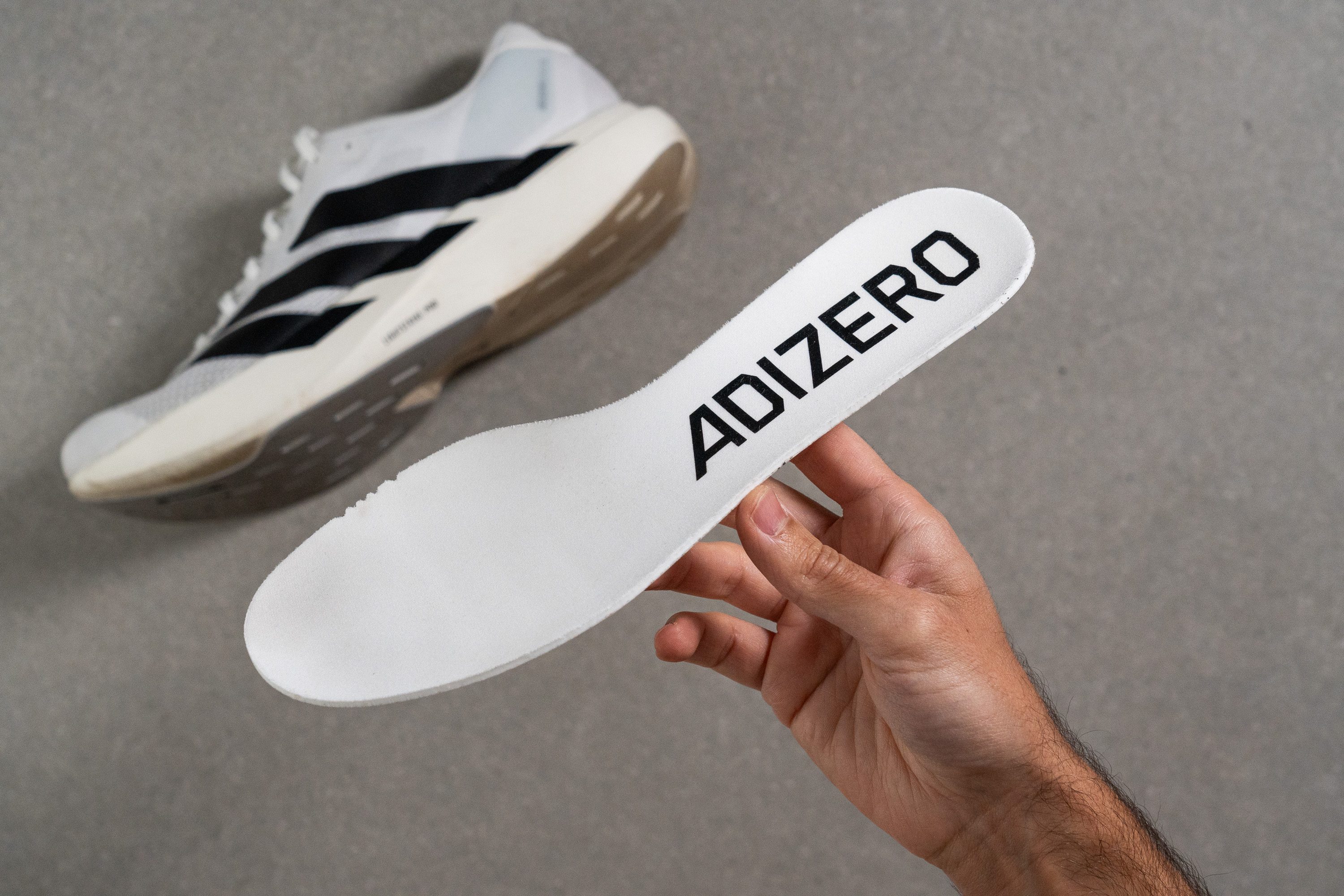
| Adizero EVO SL | Yes |
Midsole softness in cold (%)
We observed a slight 12.9% change in softness after a 20-minute freezer test—an impressive result, though entirely expected from a TPEE-based superfoam. Therefore, the Lightstrike Pro midsole feels almost the same as before even in teeth-grinding winters.
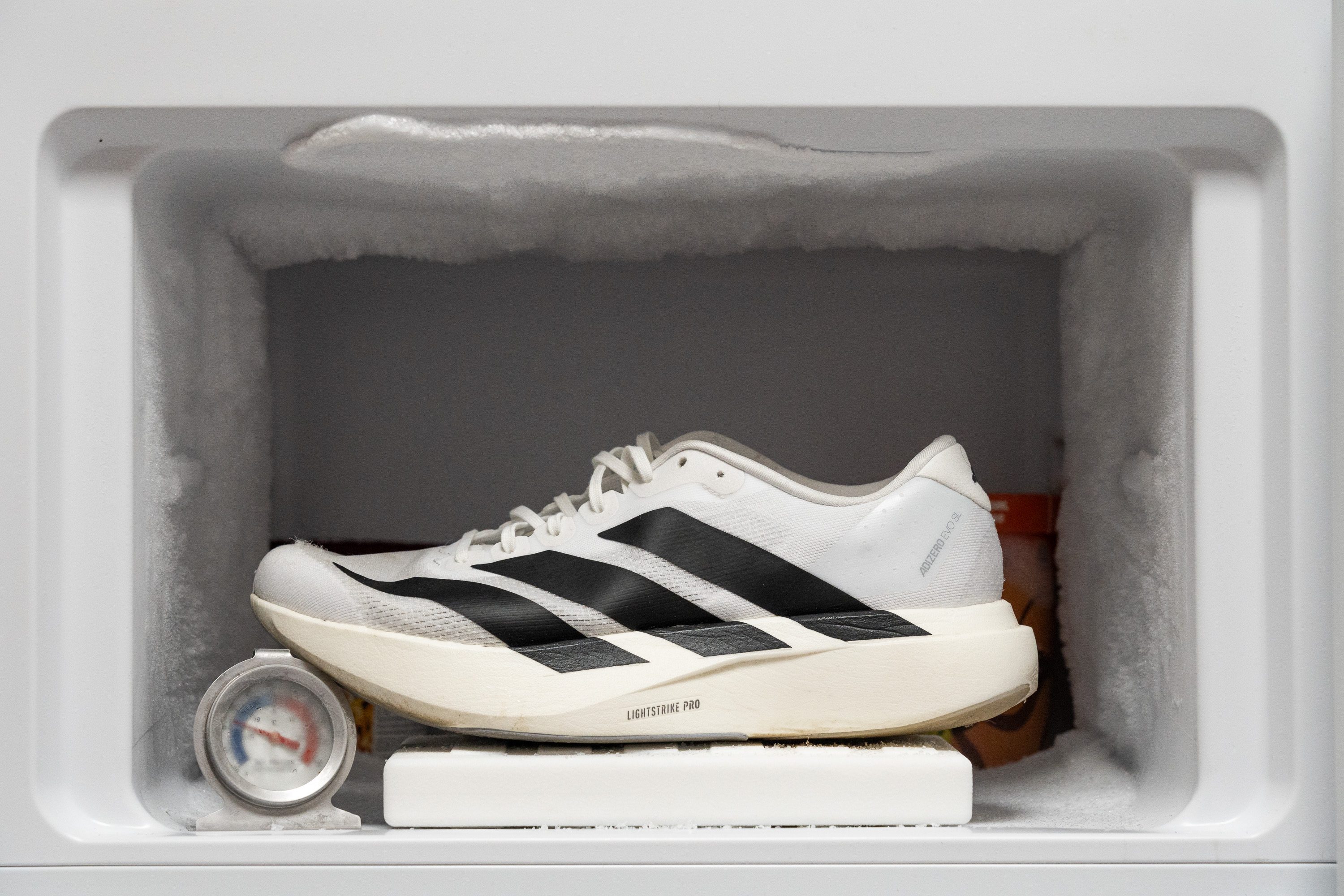
| Adizero EVO SL | 13% |
| Average | 24% |
Reflective elements
The EVO SL lacks any reflective elements—not that we were expecting them—but it would have been a nice addition nonetheless.
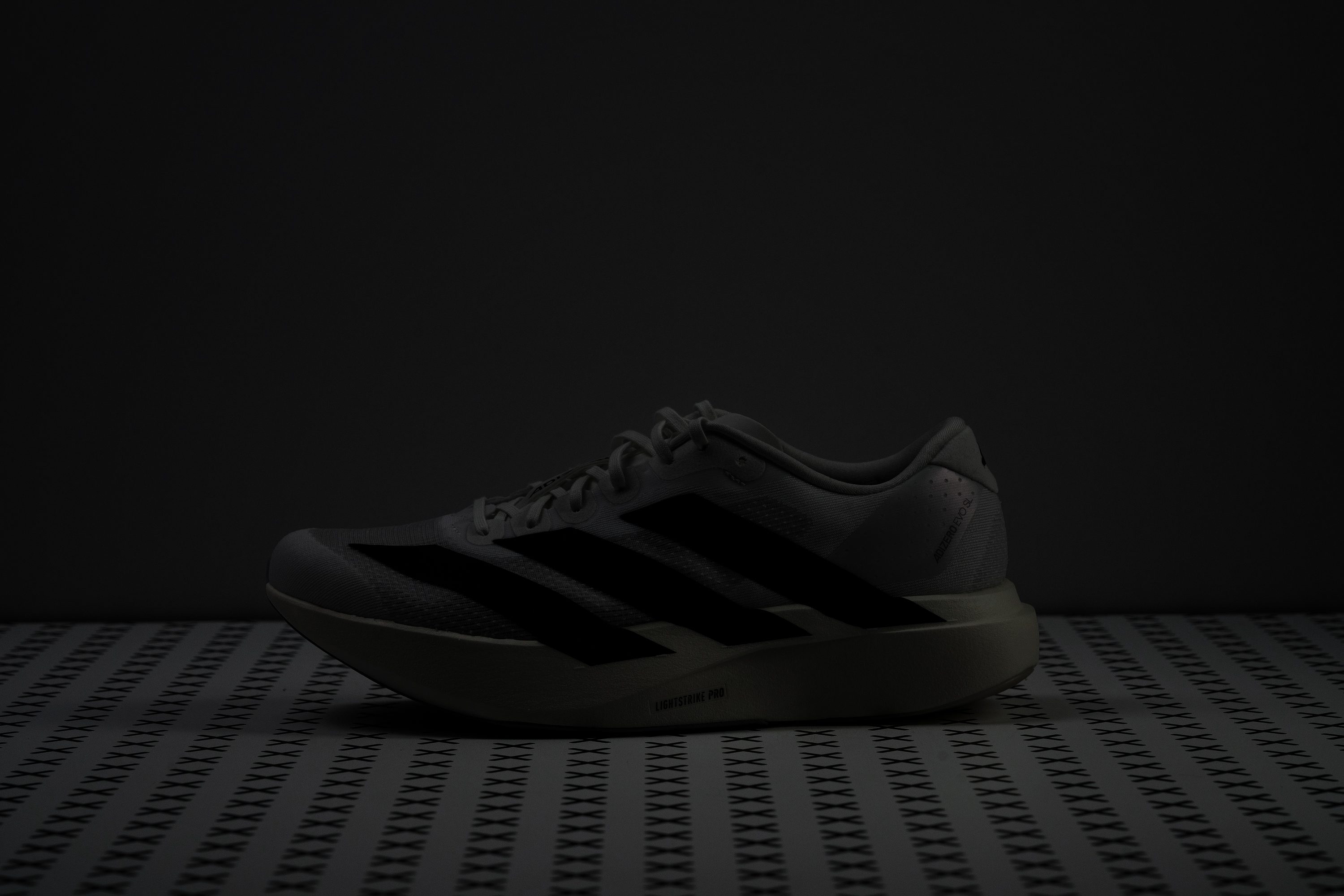
| Adizero EVO SL | No |
Tongue padding
We discovered an incredibly thin tongue at just 1.5 mm, reminiscent of competition shoes, with no padding or added comfort—purely focused on weight savings, so it’s a take-it-or-leave-it feature.
In our opinion, this is one area where we would have gladly traded a touch of weight for a thin foam layer to better protect the instep. That said, if you’re mindful when tightening the laces, there should be no discomfort during use.
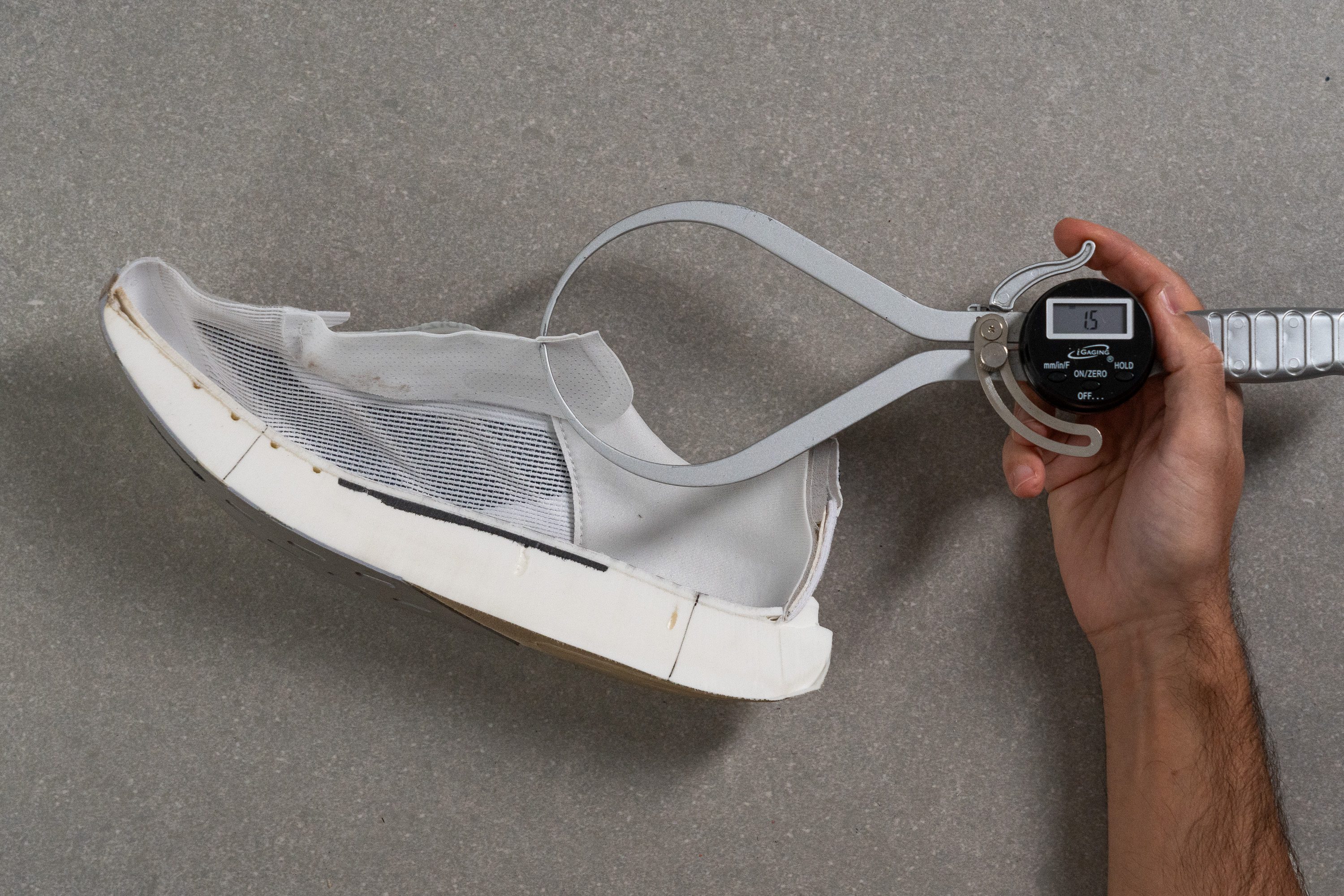
| Adizero EVO SL | 1.5 mm |
| Average | 5.8 mm |
Tongue: gusset type
While we understand that budget constraints are inevitable when aiming for an excellent value-performance ratio like the EVO SL offers, the lack of a gusseted tongue was an unexpected letdown. Many daily trainers, even those at a lower price point, include gusseted tongues.
This shortcoming feels even more frustrating because the midsole, outsole, and overall ride are so well-executed that any flaw stands out so much. It’s not a deal-breaker by any means, but from our perspective, it seems like a small, easy-to-fix issue Adidas should have resolved. Perhaps they wanted to save some enhancements for version 2!

| Adizero EVO SL | None |
Price
The MSRP of this running shoe is nearly unbelievable when considering its features—unheard of among top-tier brands from the US or Europe. Even if Adidas had priced it £30 or £50 higher, we’d still recommend it—that says it all.
Consider this: a lightweight running shoe featuring one of the best foams in the market, paired with a world-class Continental outsole, capable of excelling at any running pace, all for the price of an average daily trainer. That's the Adidas Adizero EVO SL.
| Adizero EVO SL | $150 |
Heel tab
This was a surprise! Unlike most shoes in the Adizero lineup, such as the 5K/10K racer Takumi Sen 10, the EVO SL skips the flap-like heel tab design entirely.
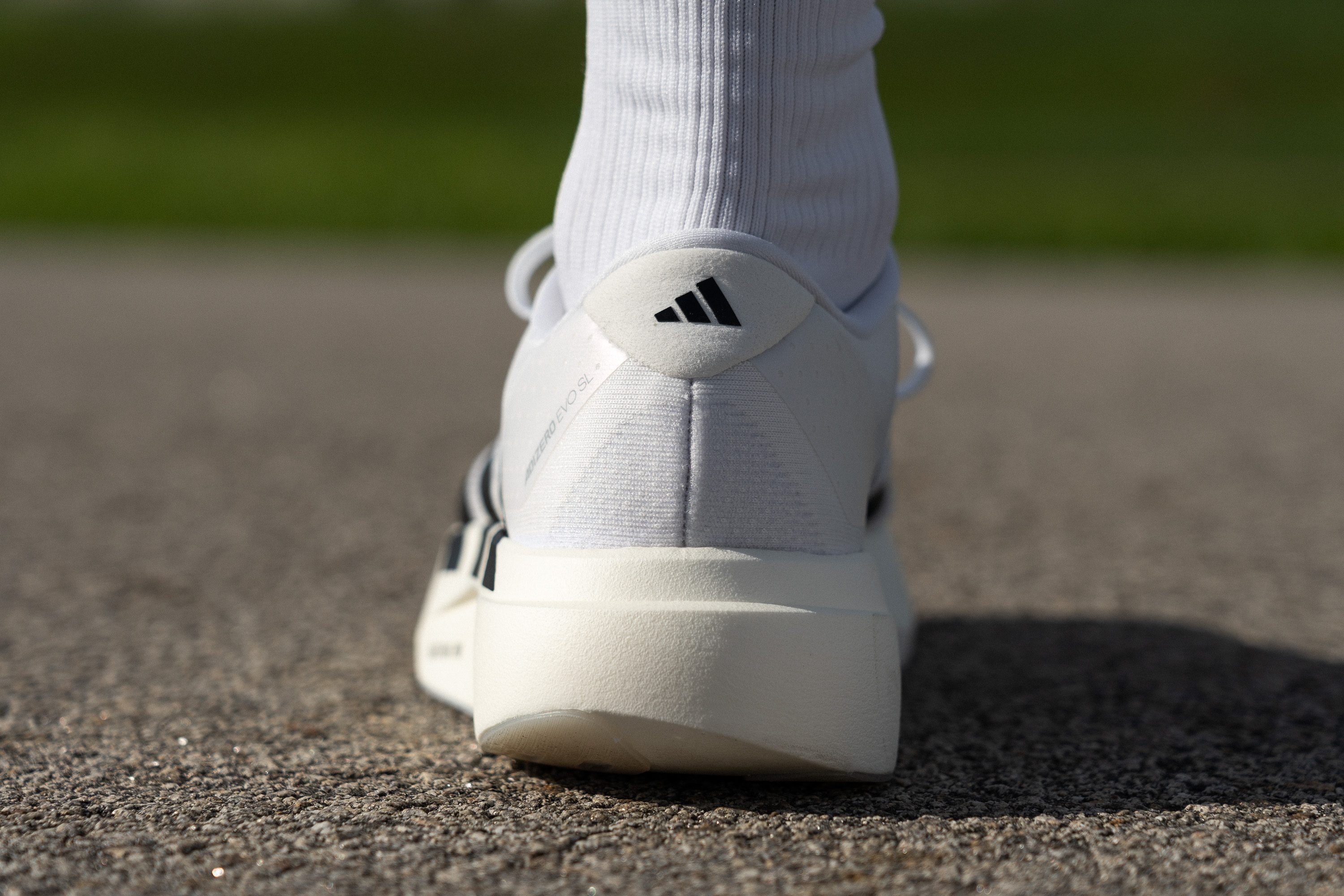
| Adizero EVO SL | None |
Lacing system
For fans of the runner's knot, there’s an extra eyelet available, but we believe there’s a better alternative—using the second-to-last eyelet instead. Given the short tongue on the EVO SL, we found that a traditional runner's knot at the top eyelet might create uncomfortable pressure on the instep. However, as you can see, we did fine with a regular knot.
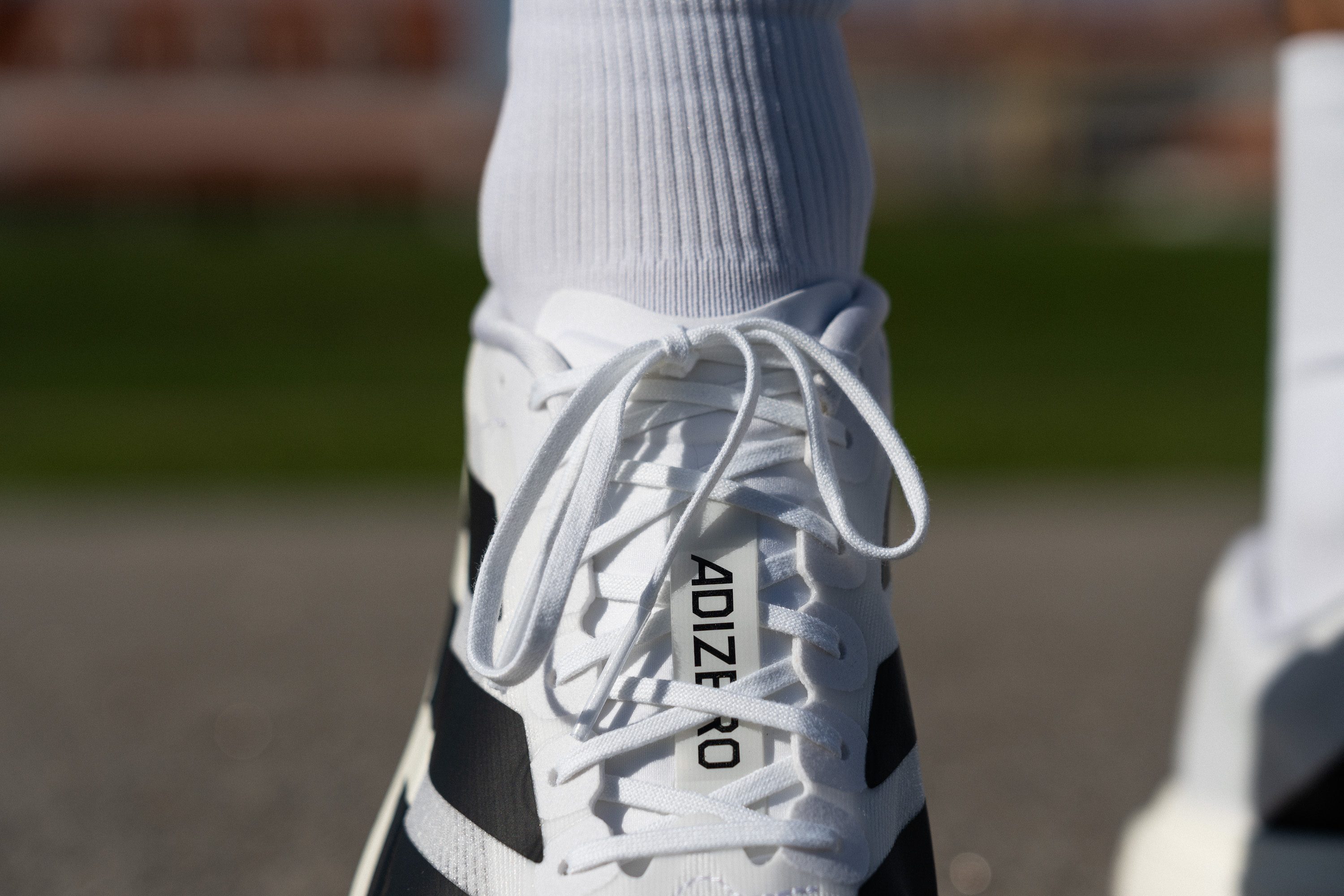
Nonetheless, we were generally pleased with the lacing system, which incorporates punched eyelets reminiscent of the Evo 1’s design. But we need to point out one persistent issue with Adidas—the laces are frustratingly subpar, a recurring problem across all Adizero shoes that, unfortunately, still hasn’t been addressed in 2024.
